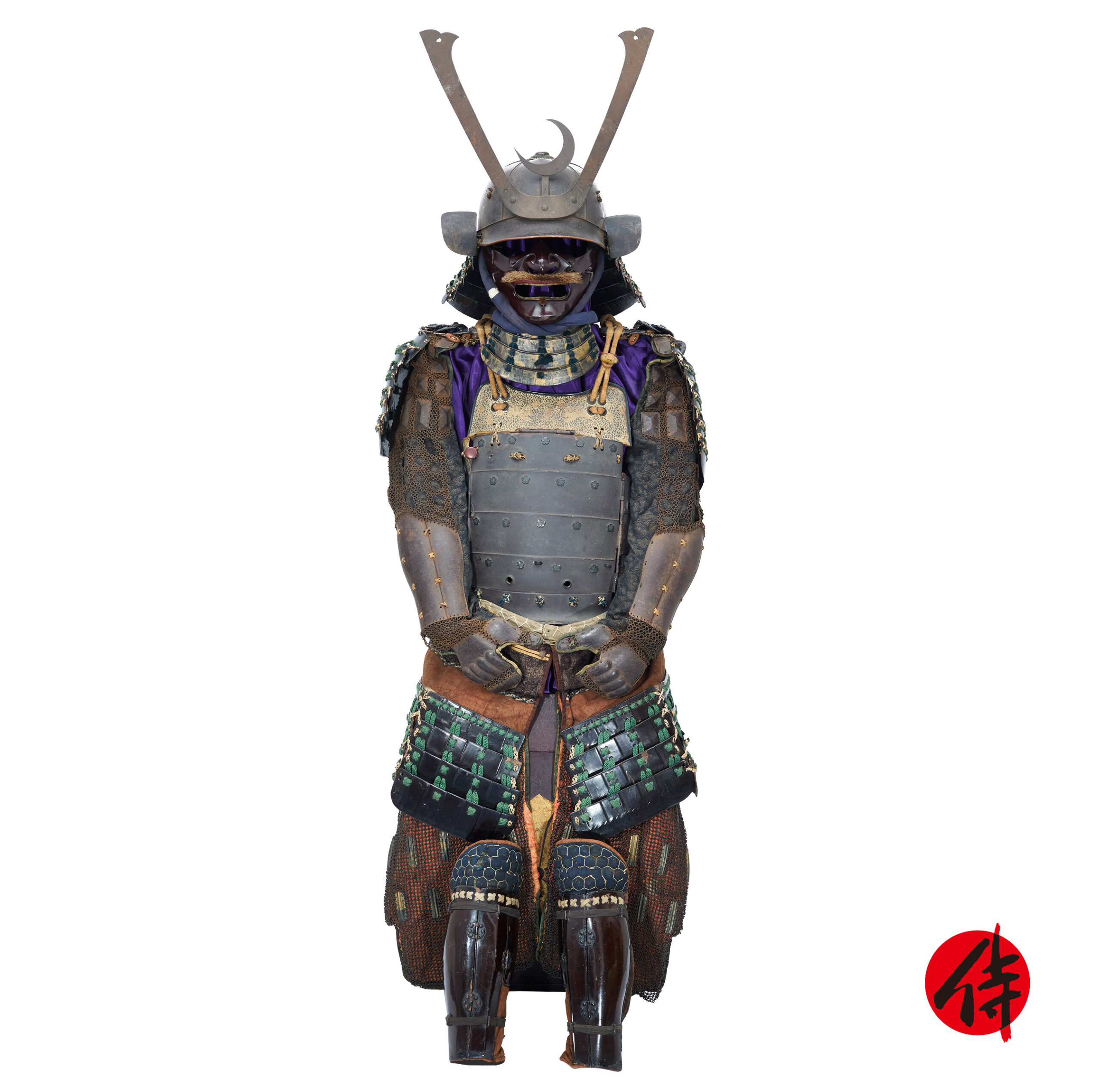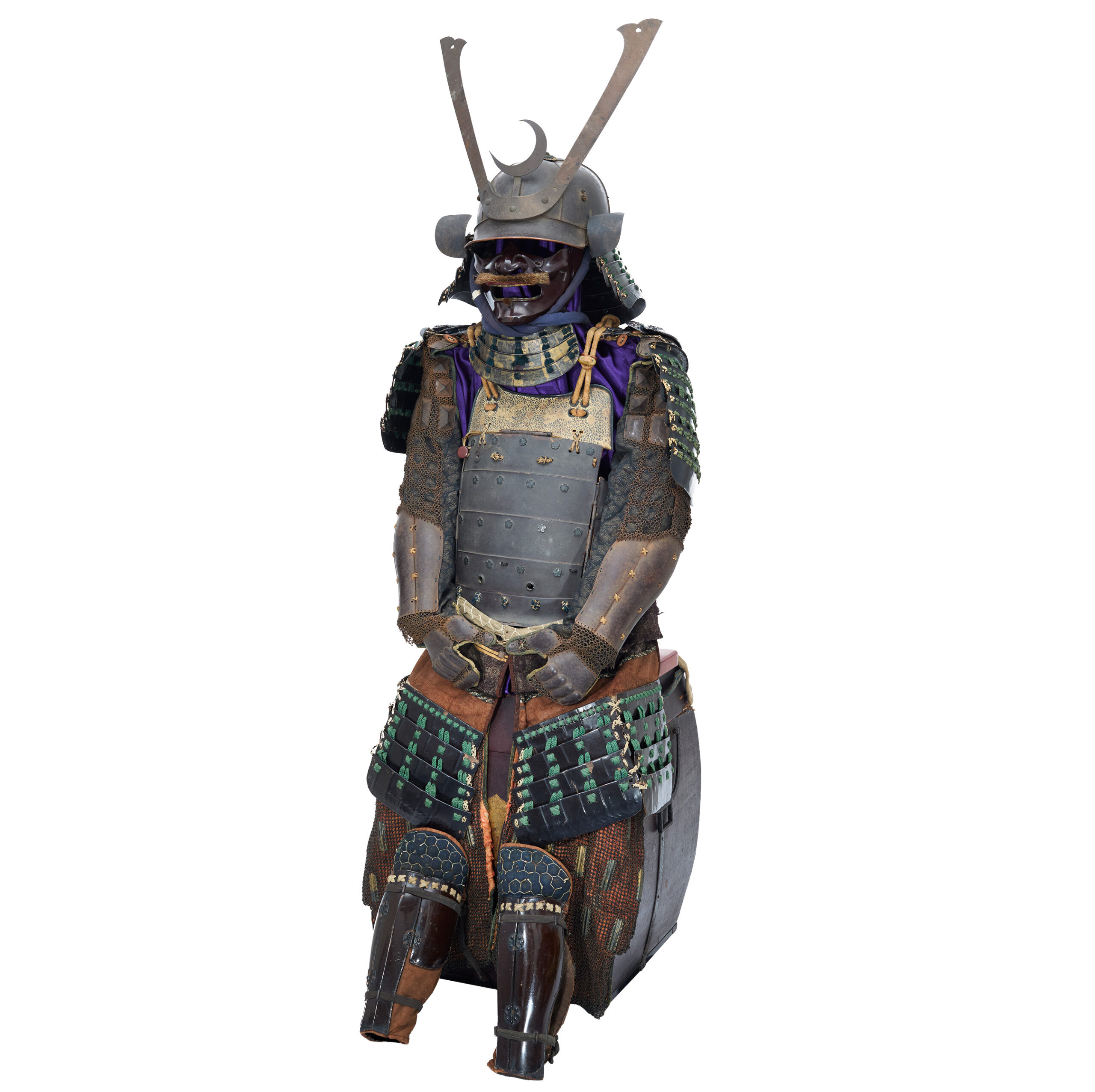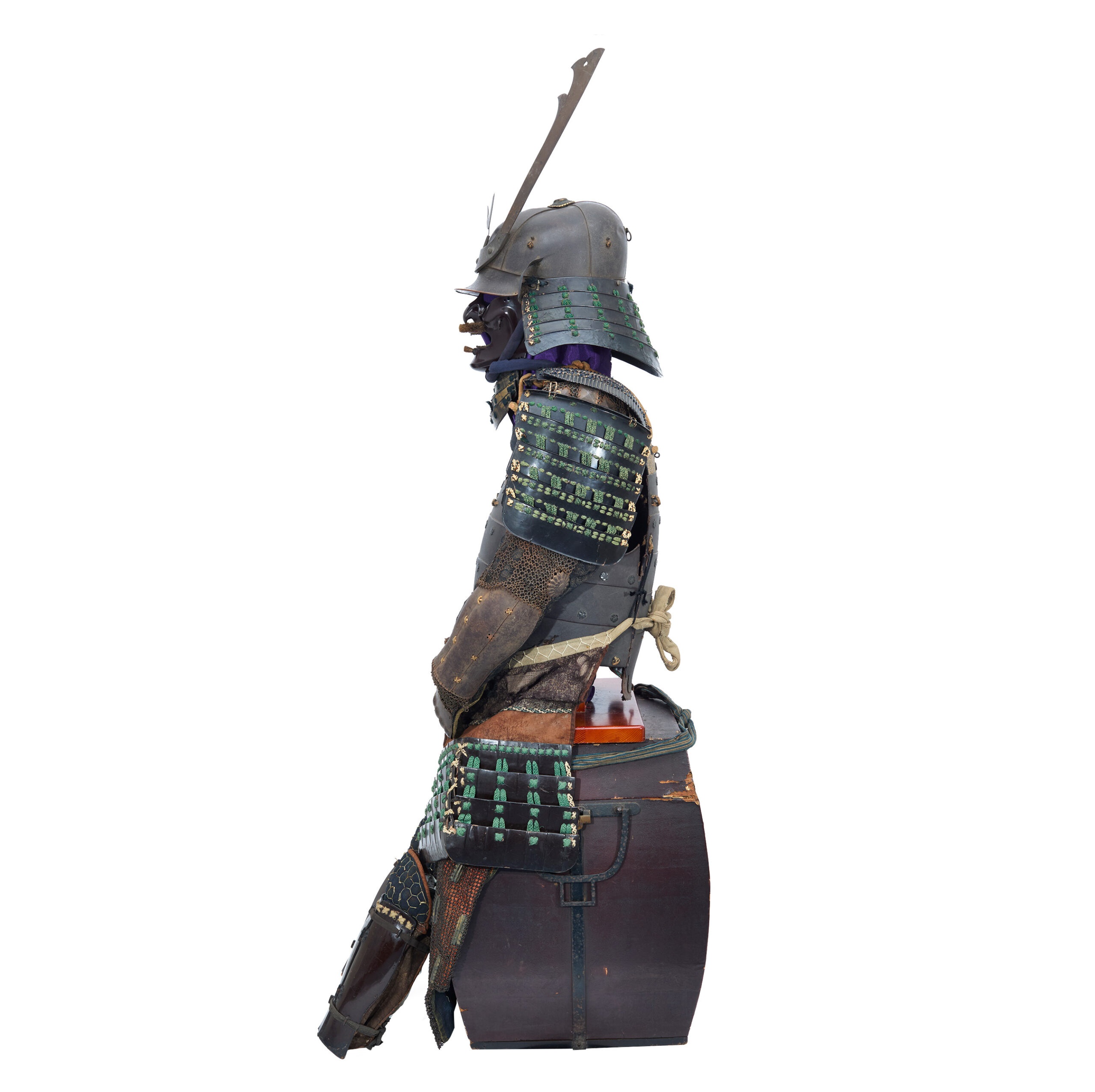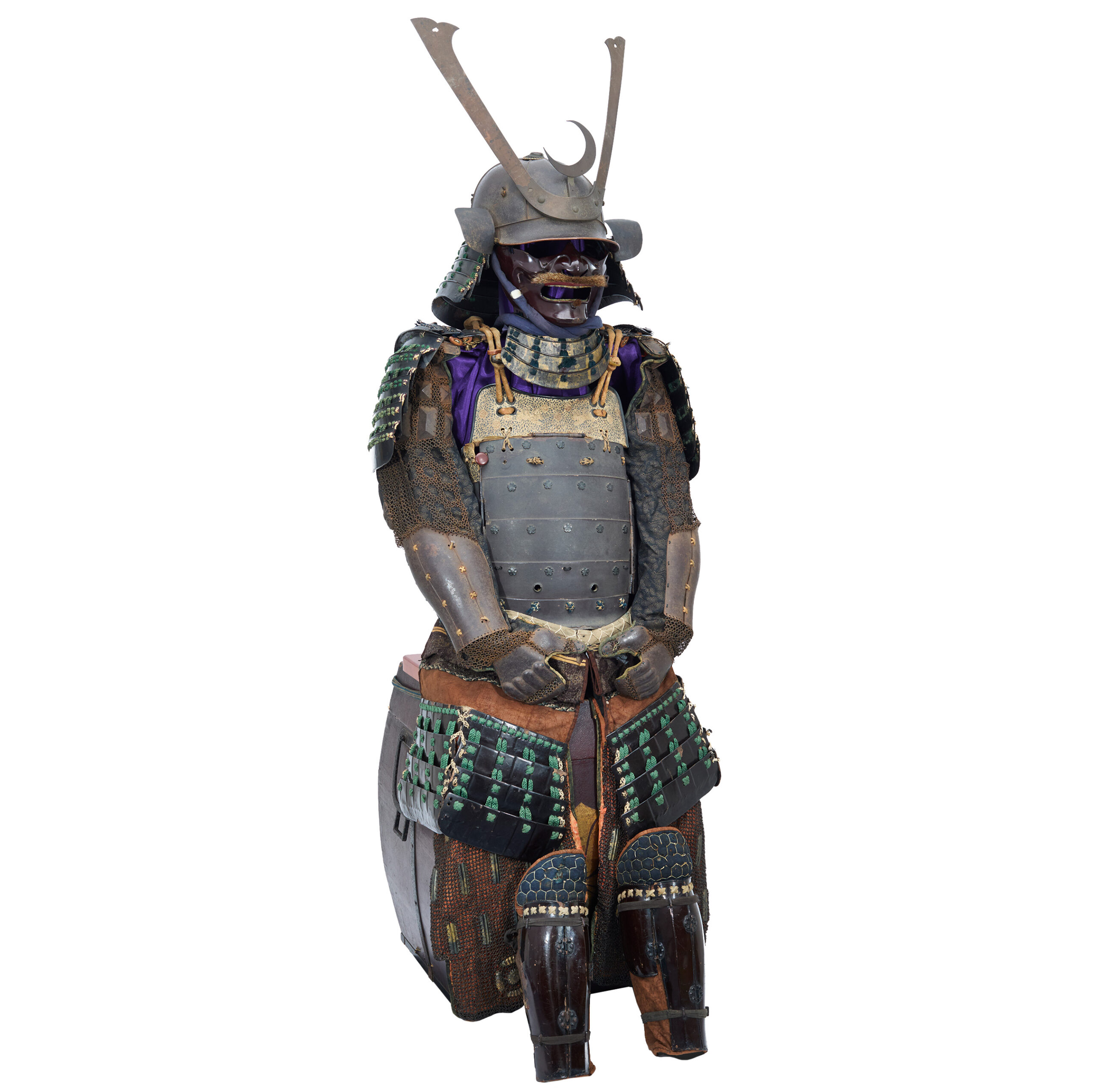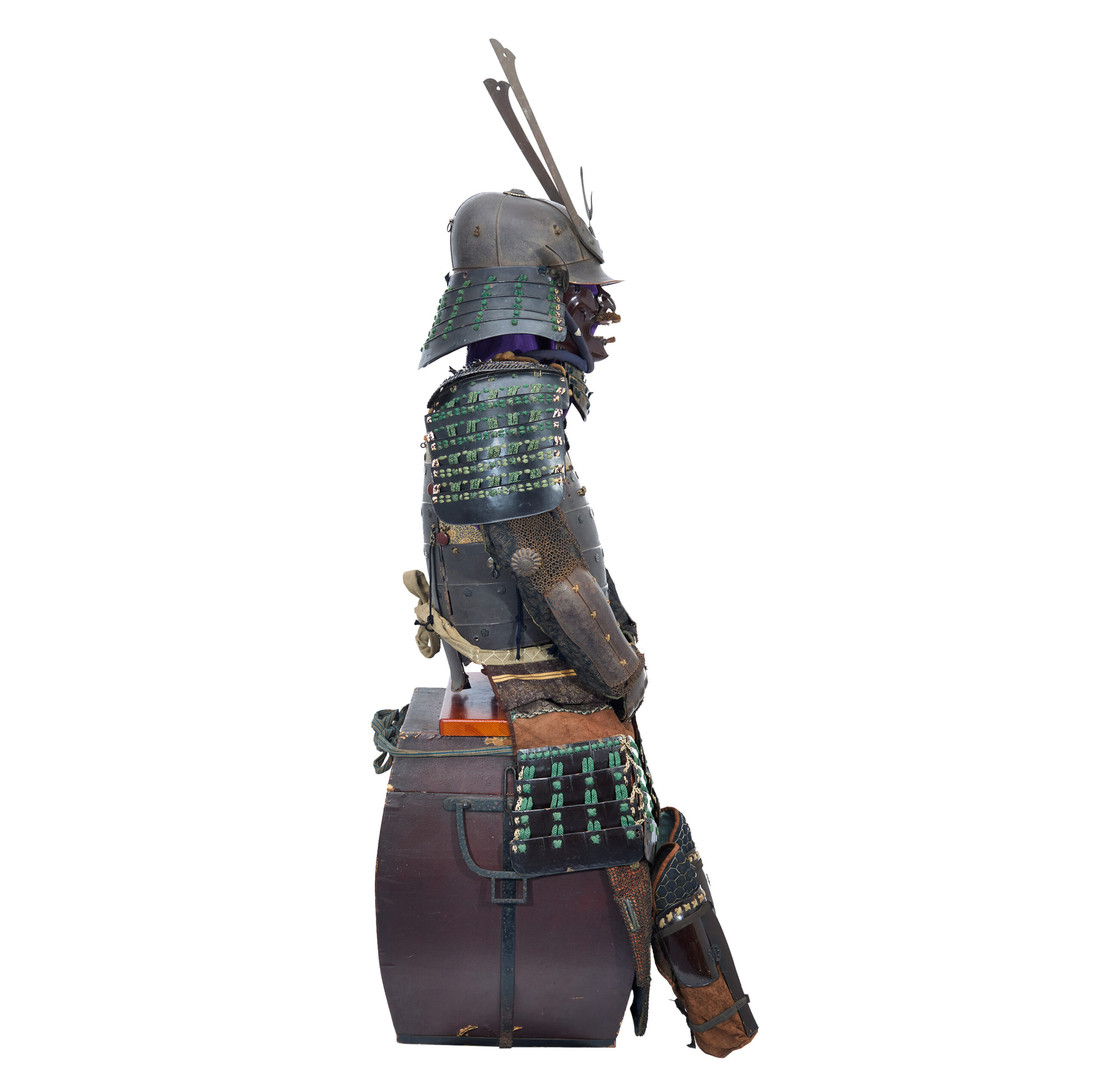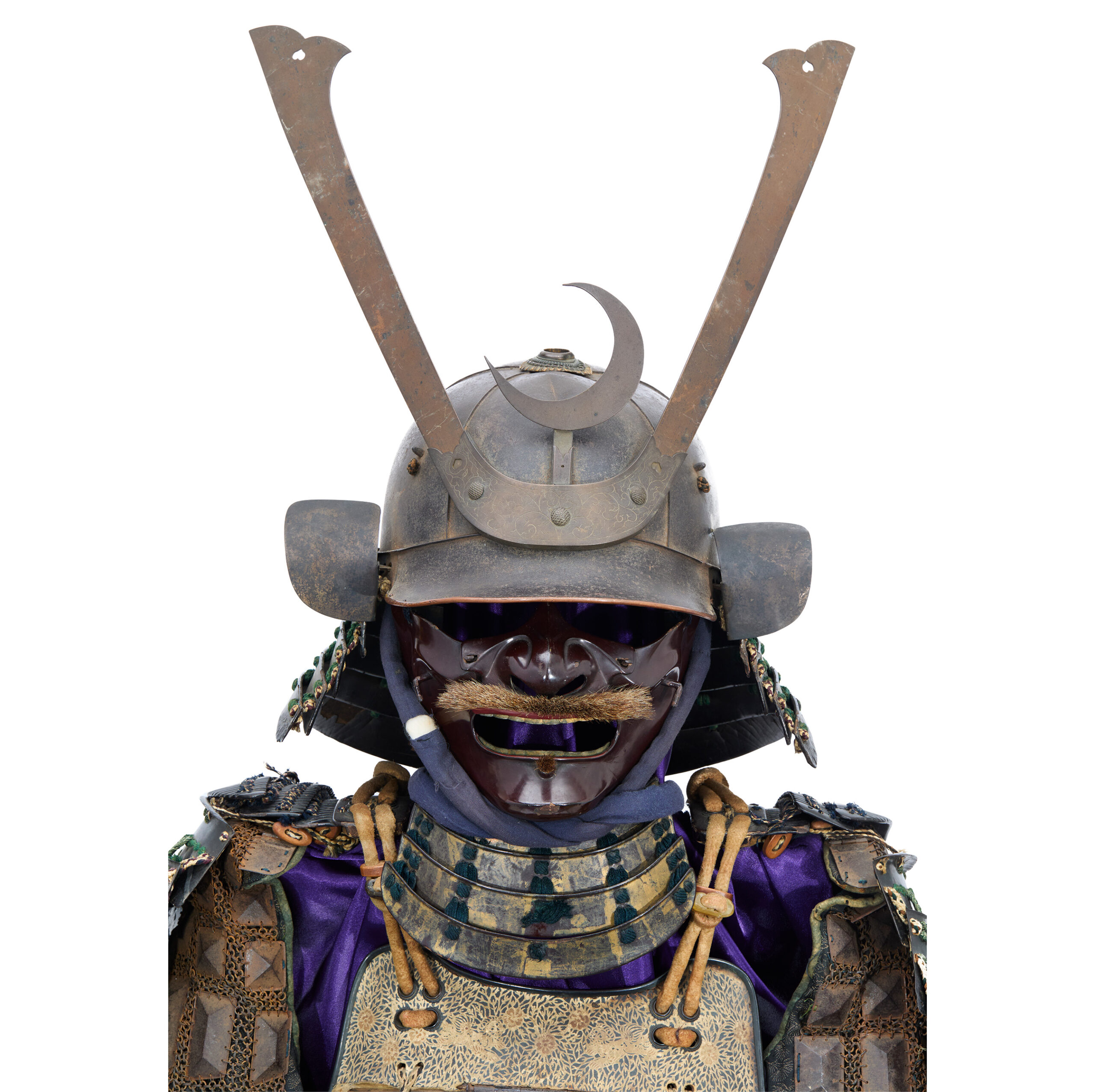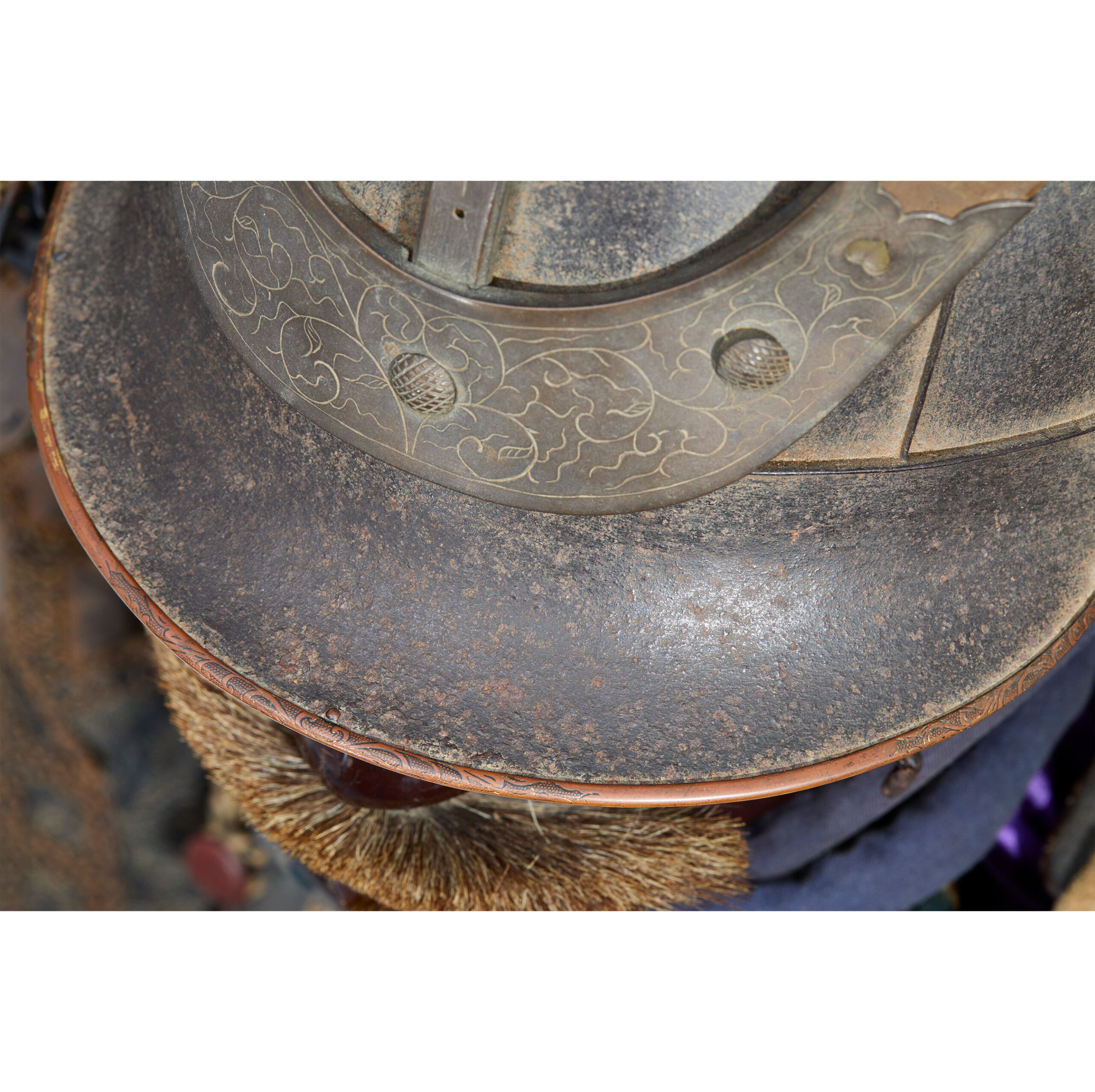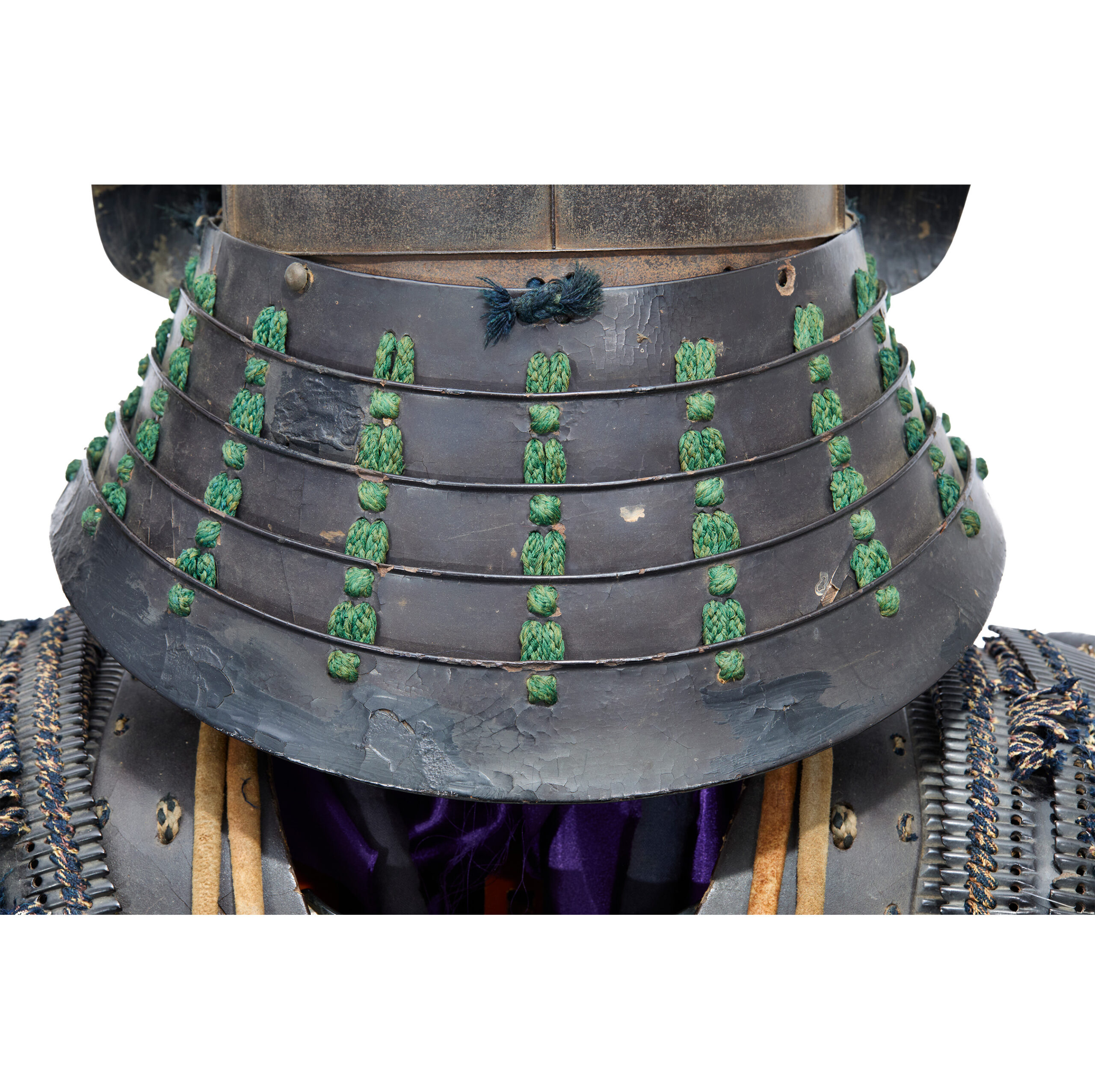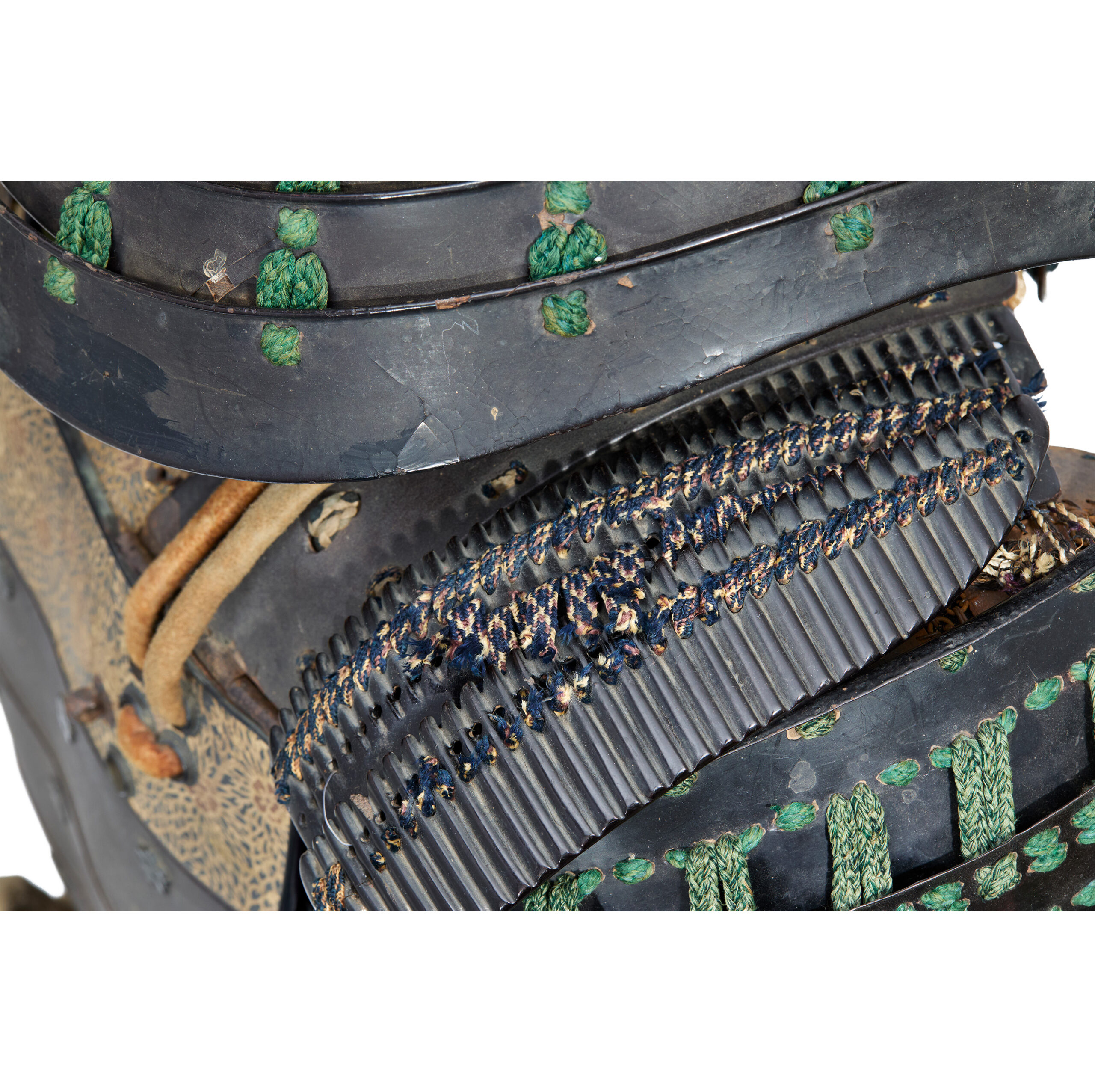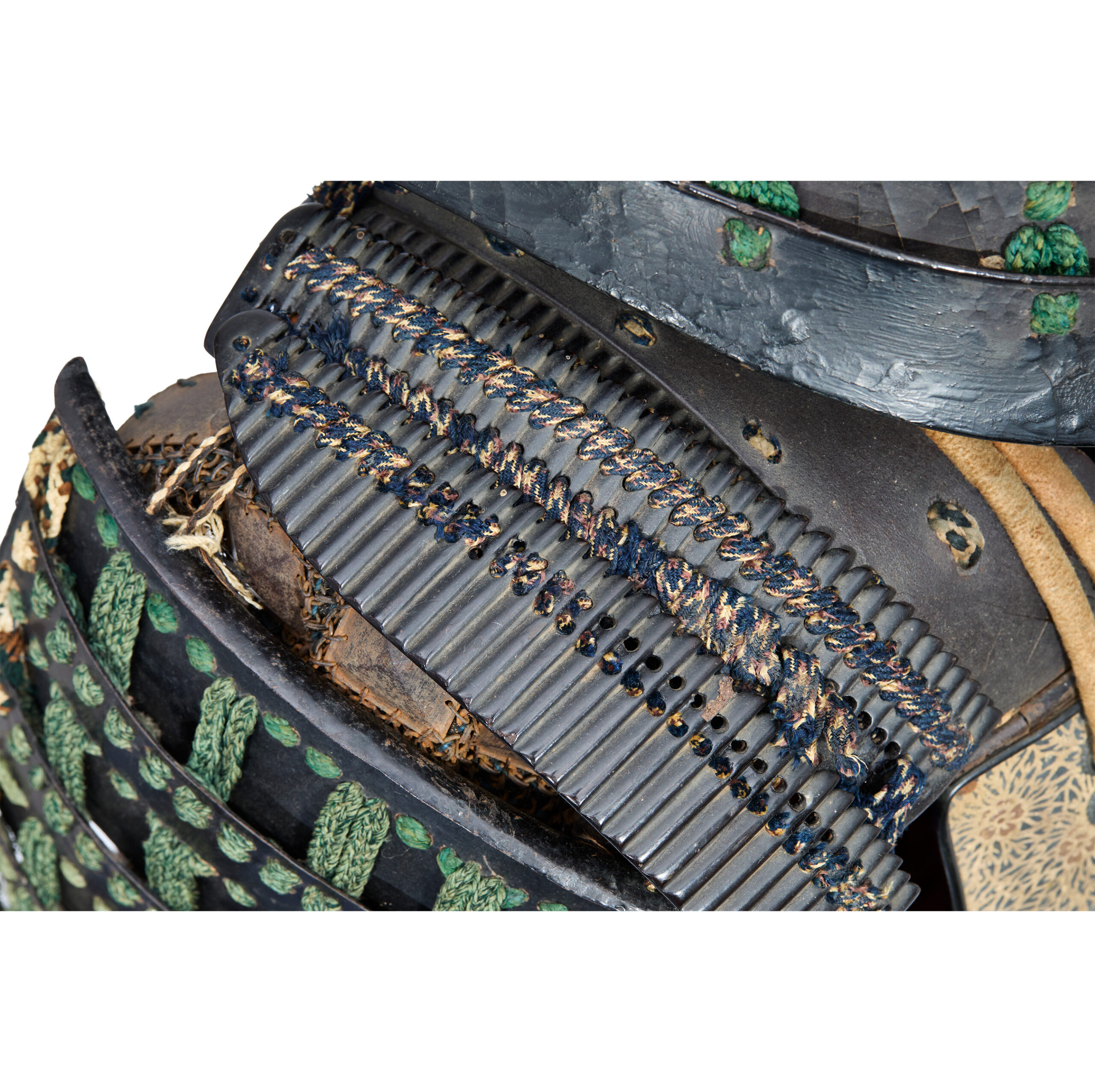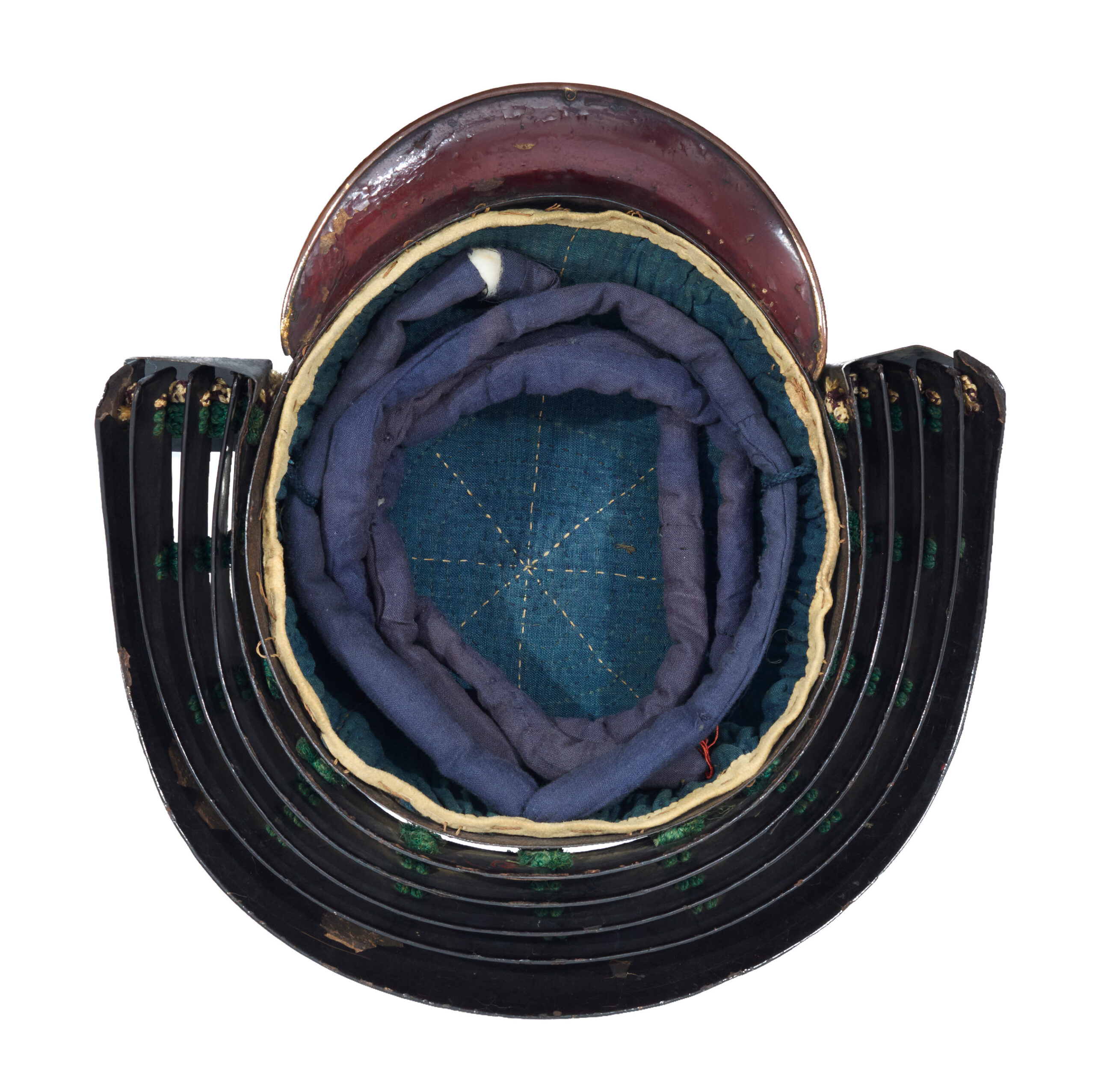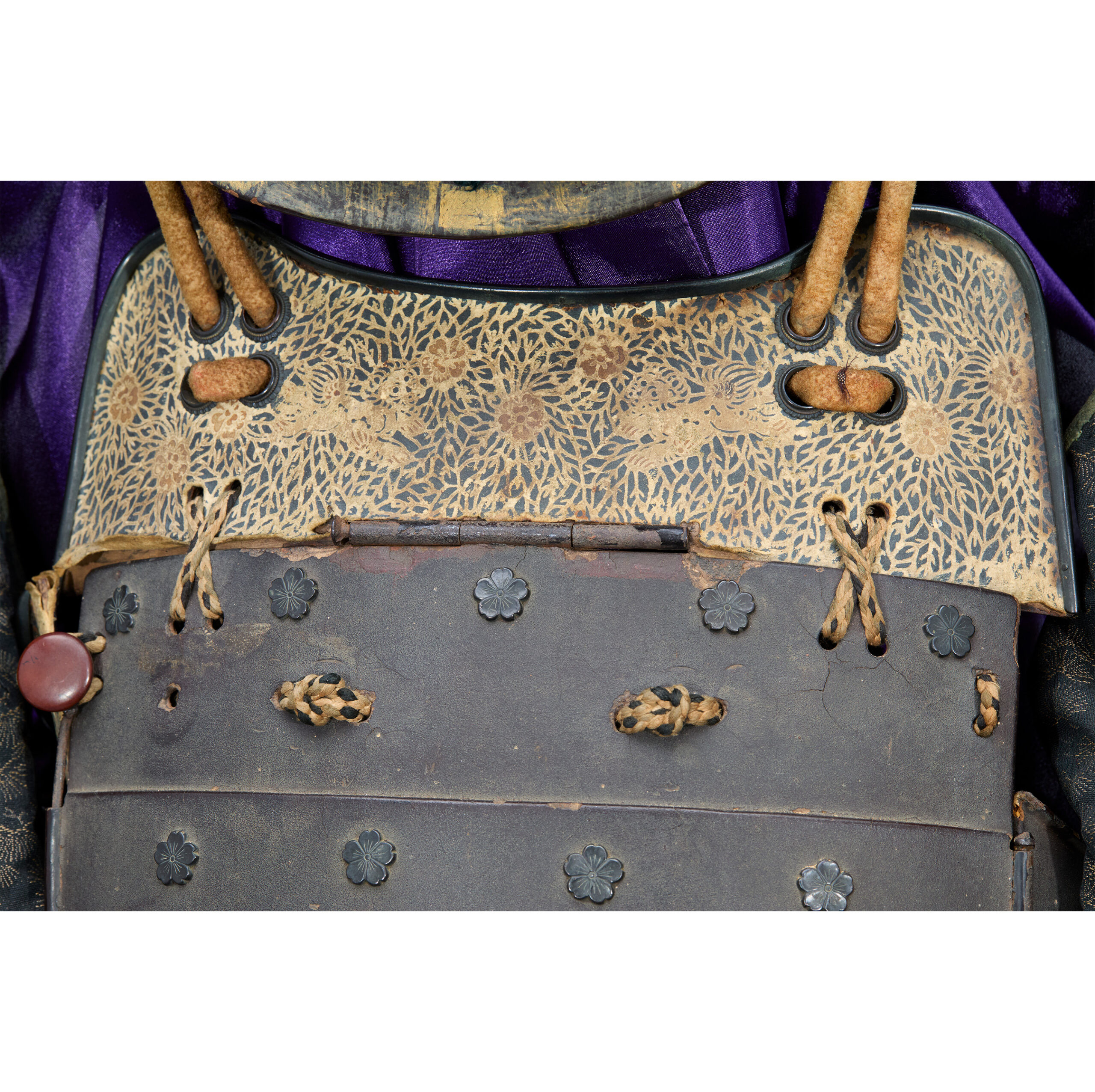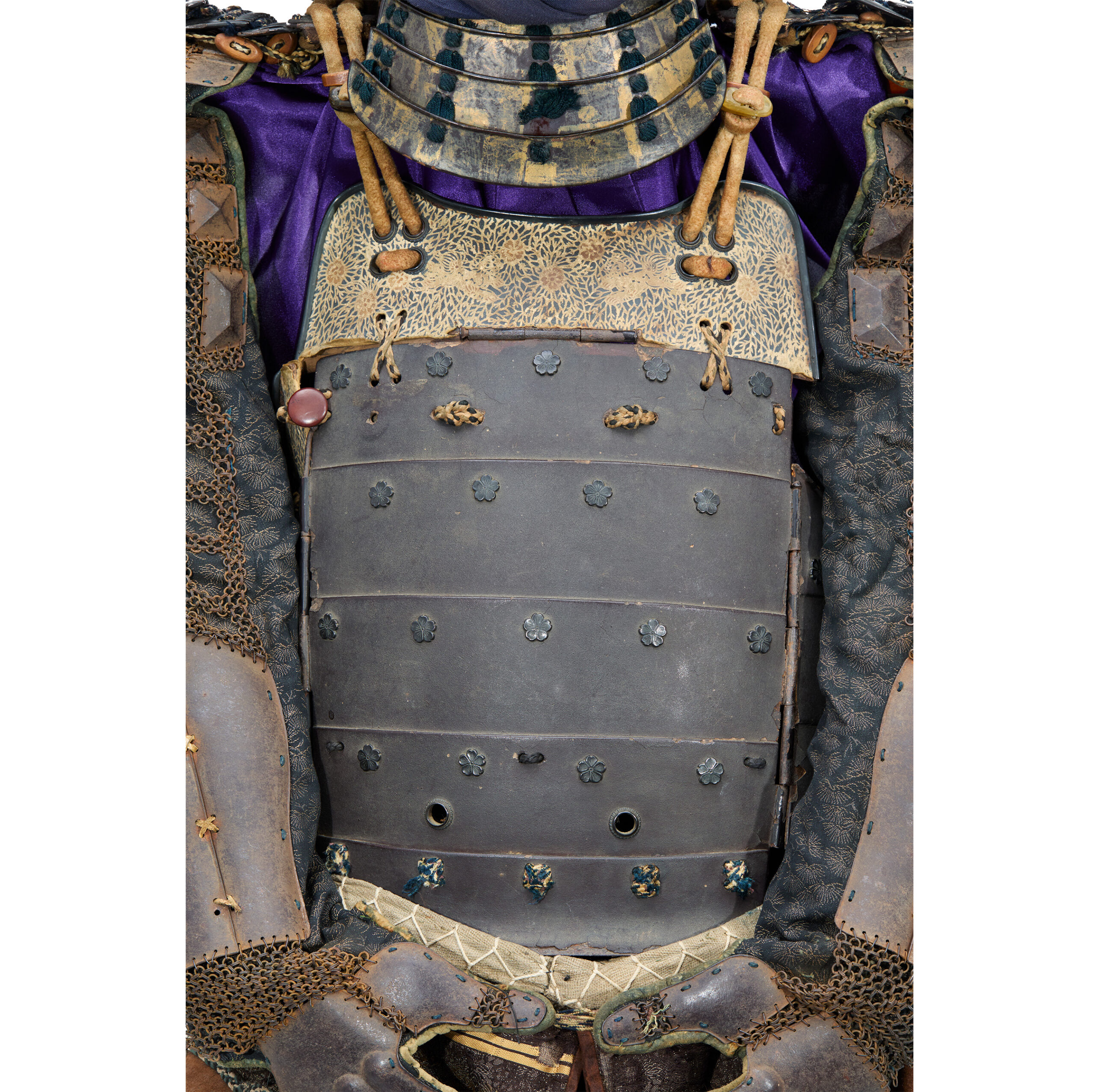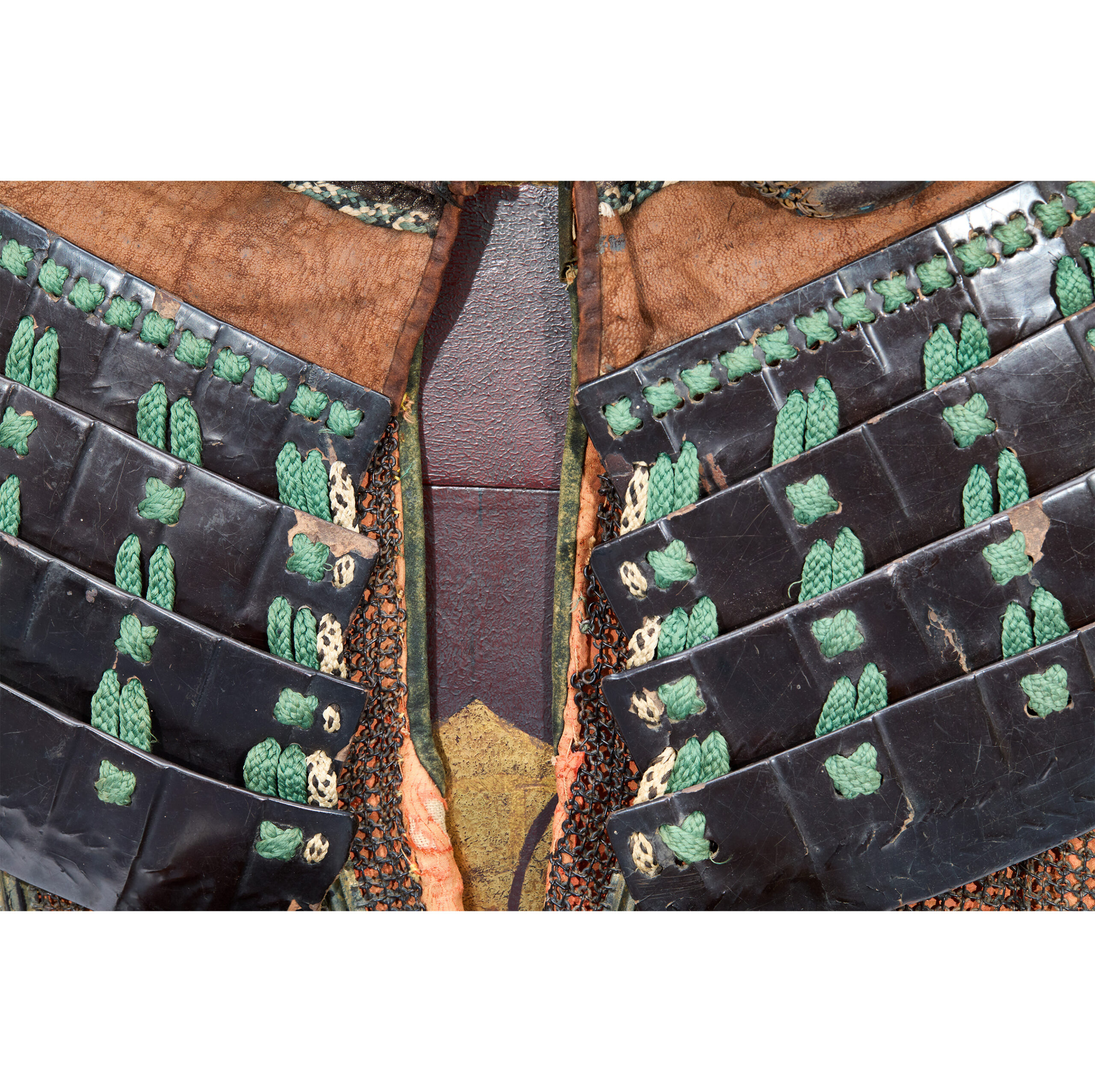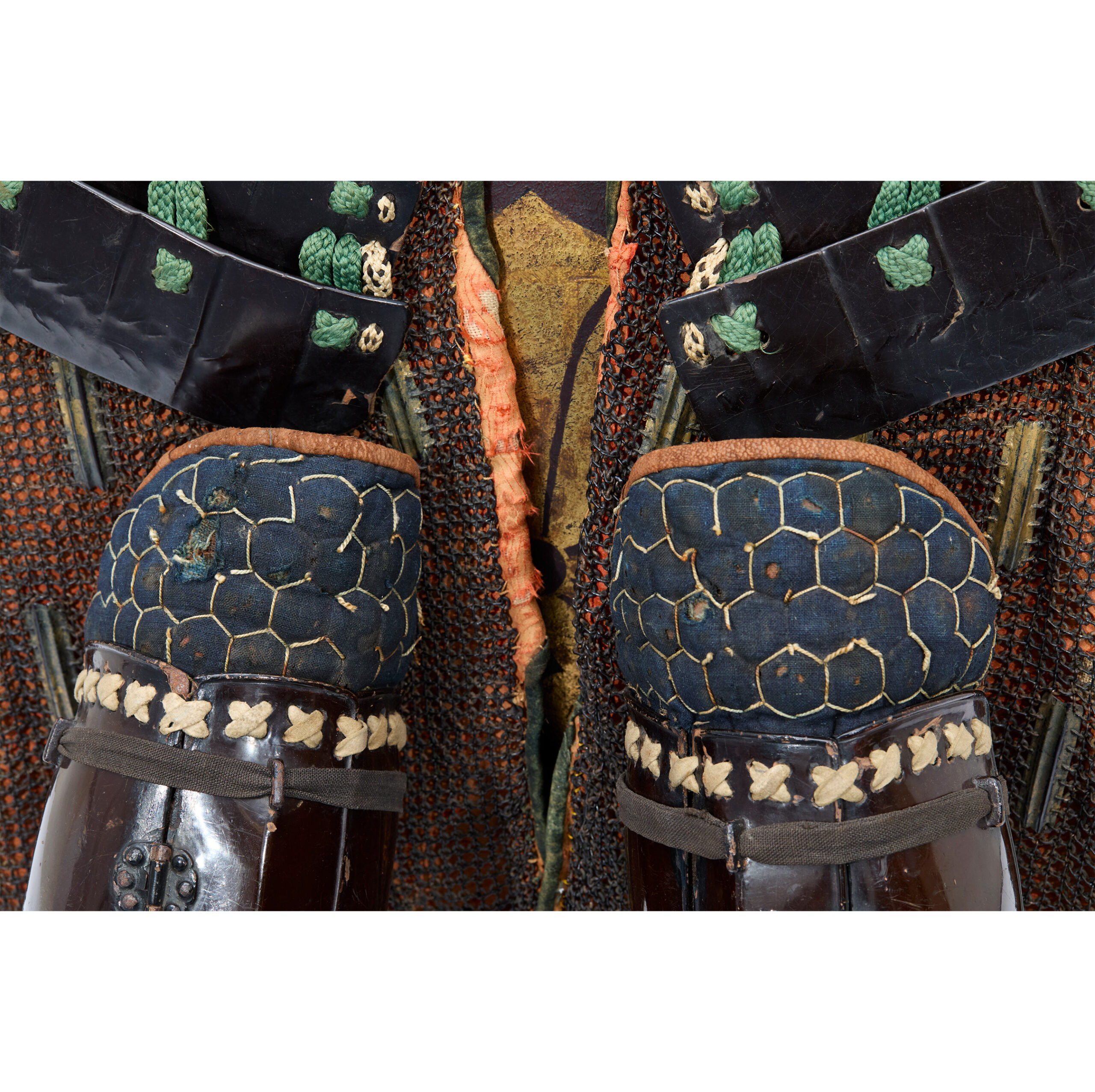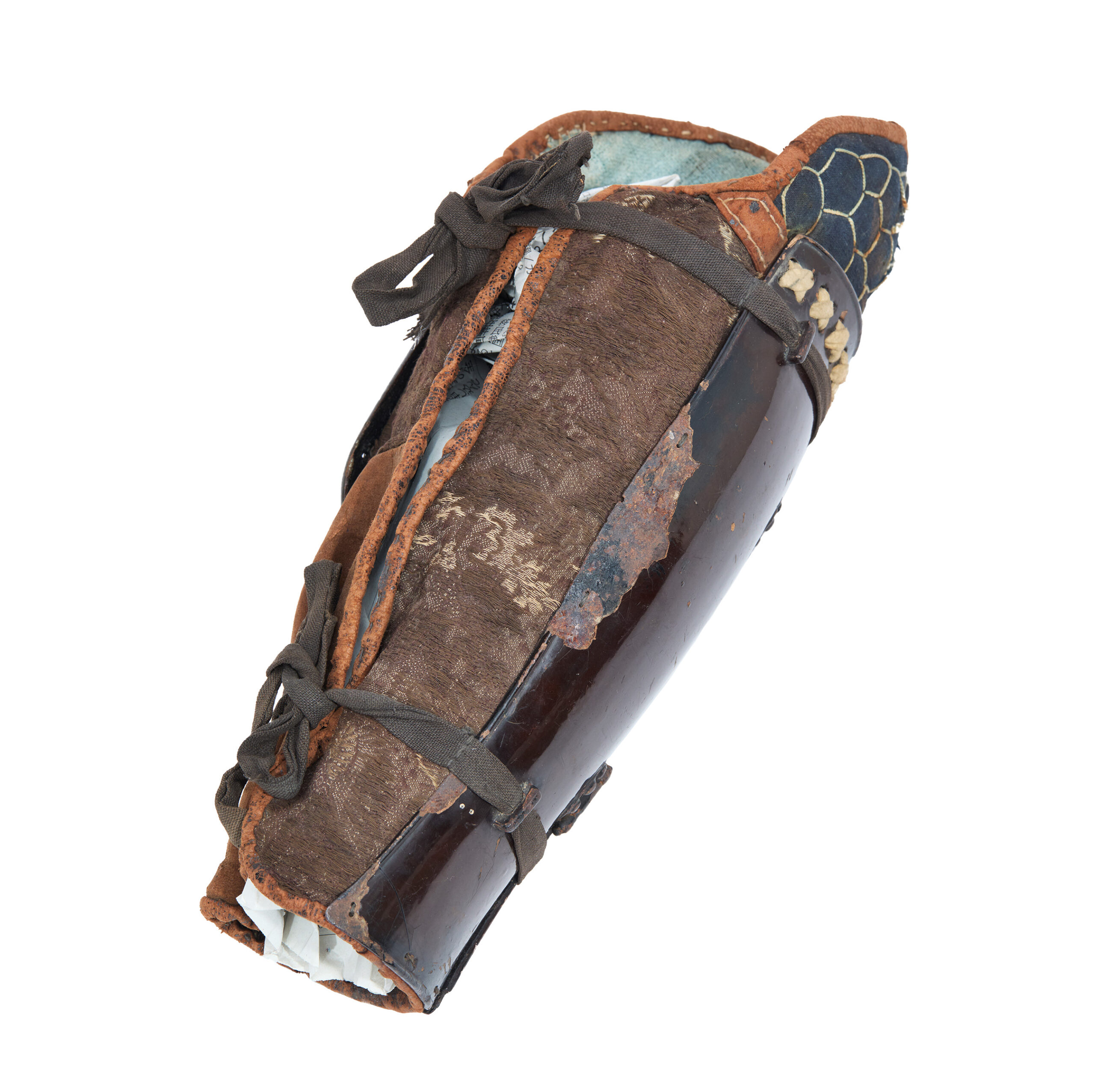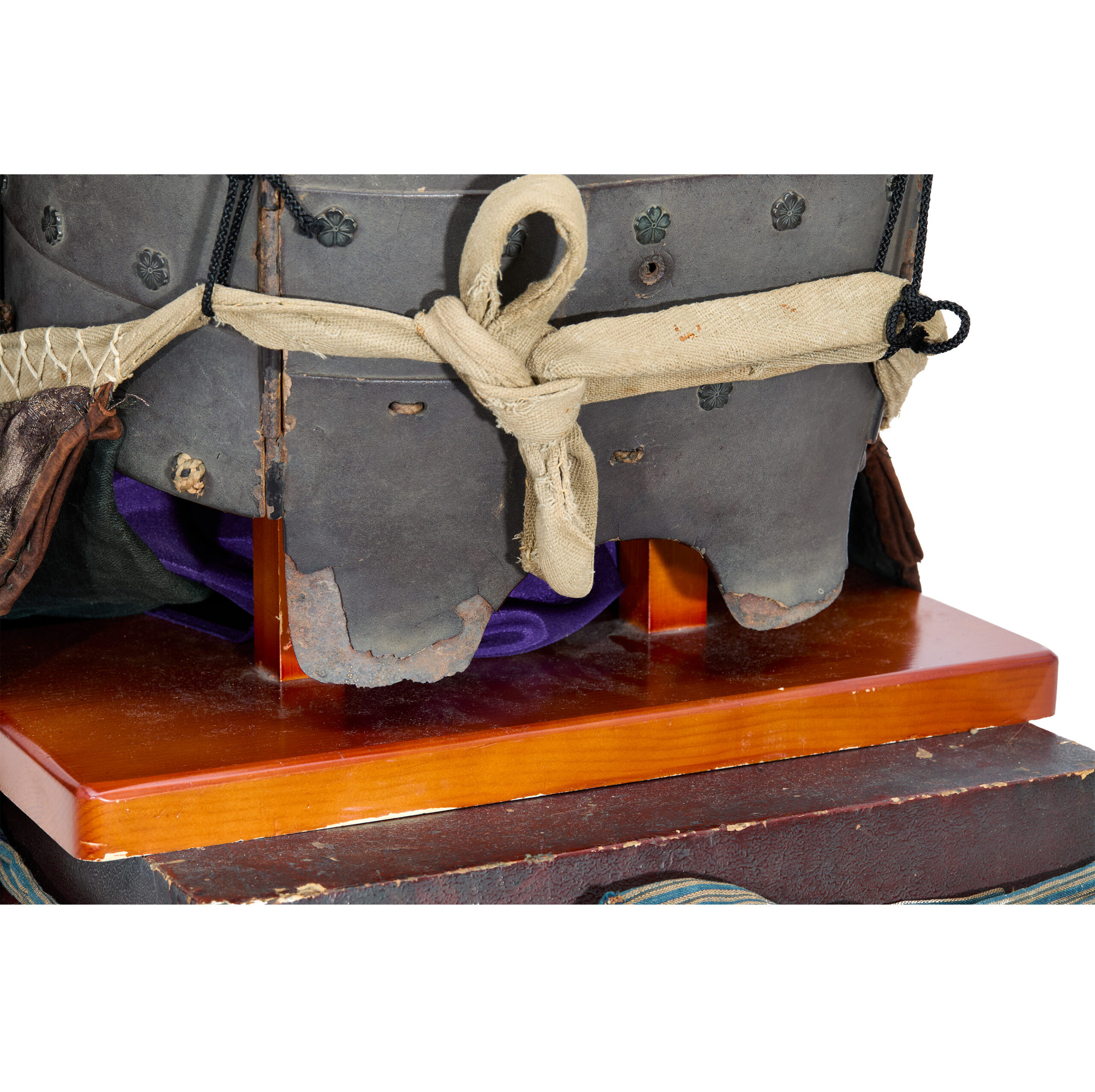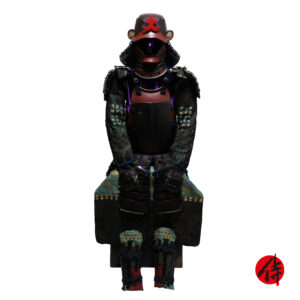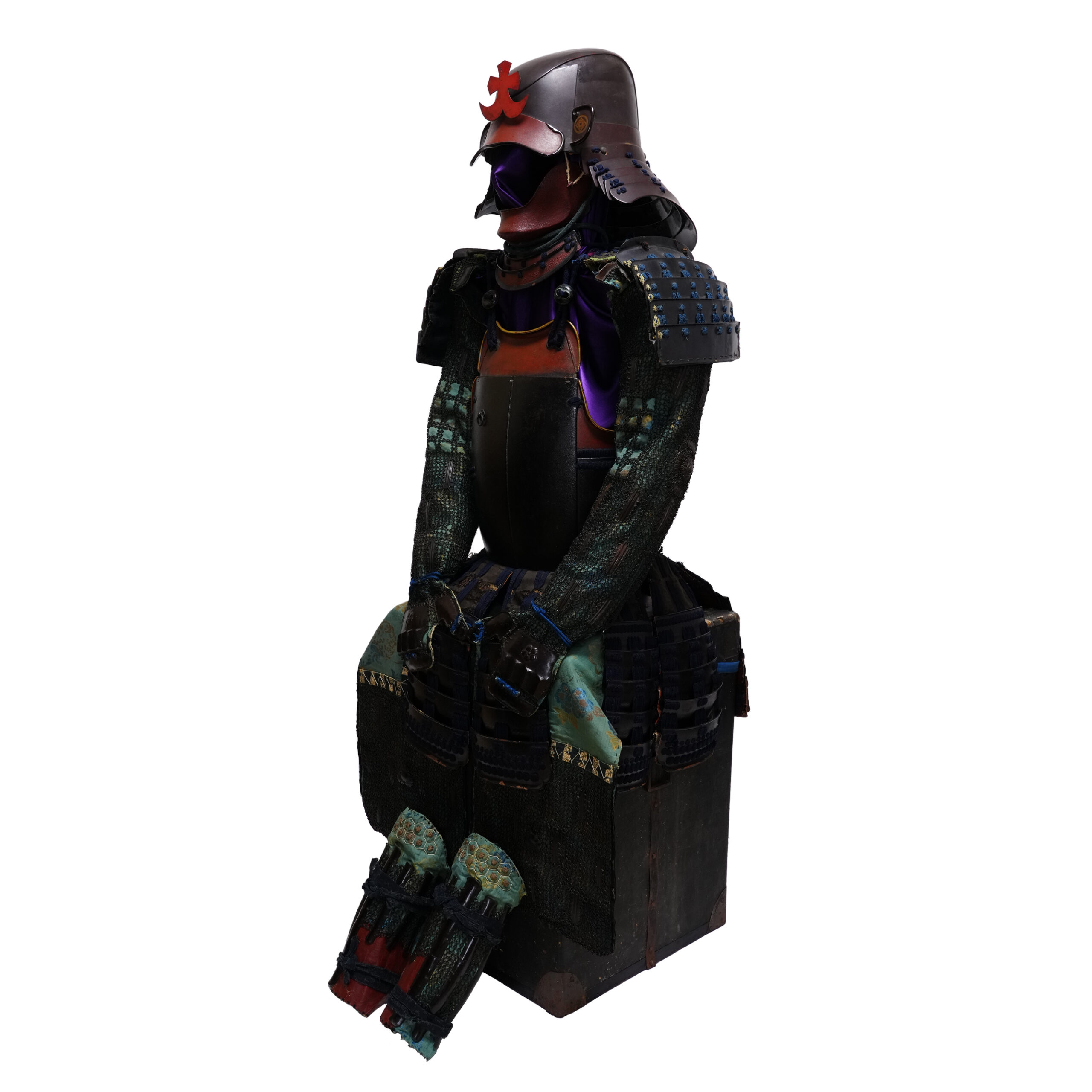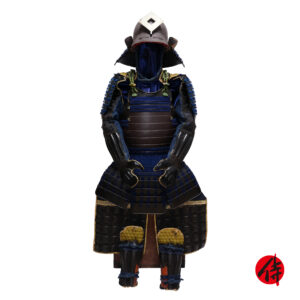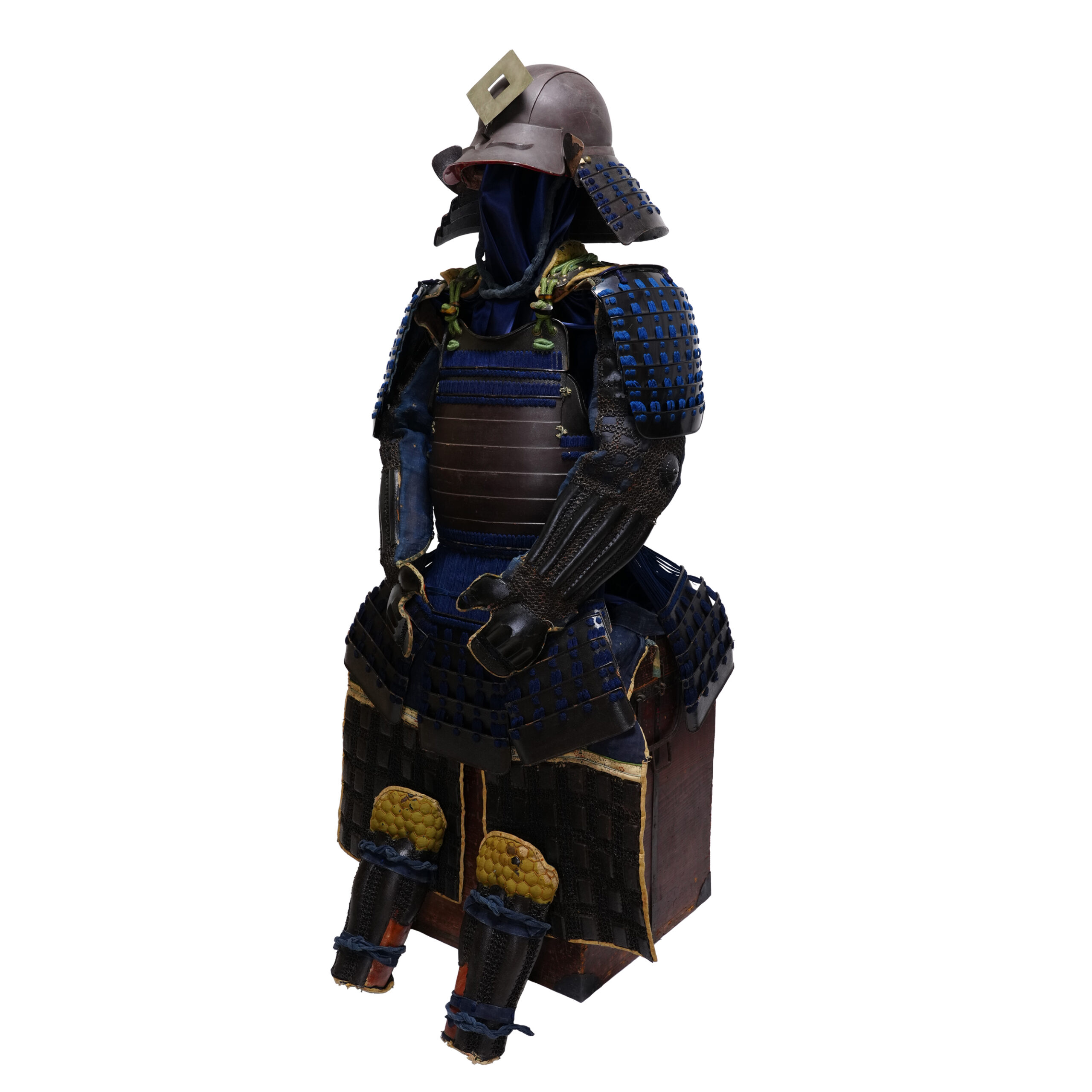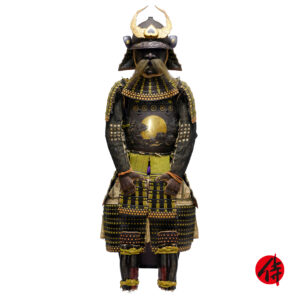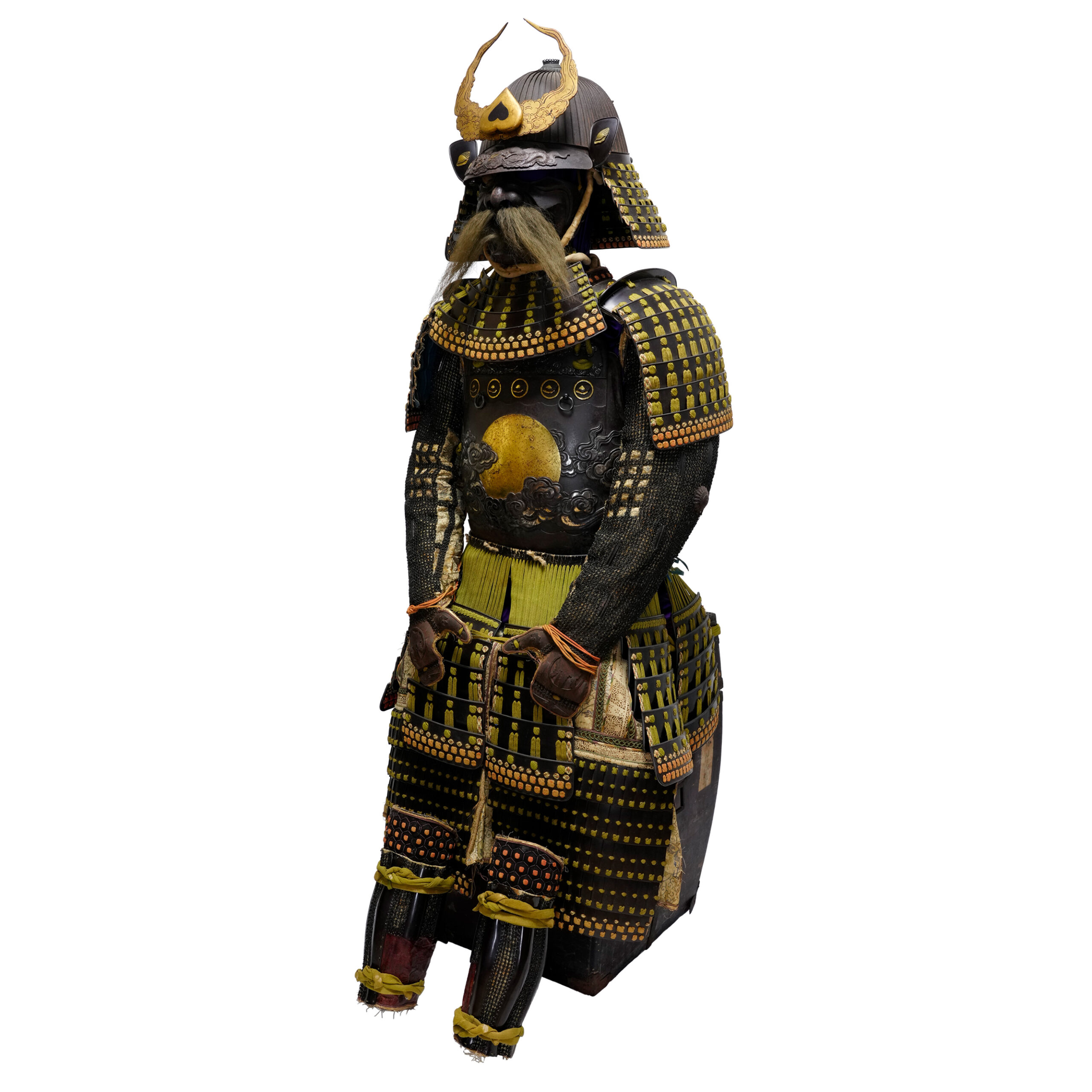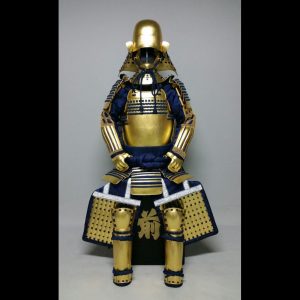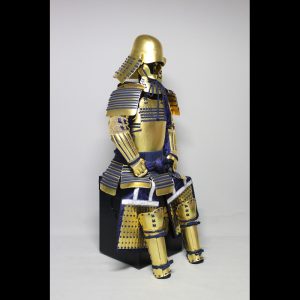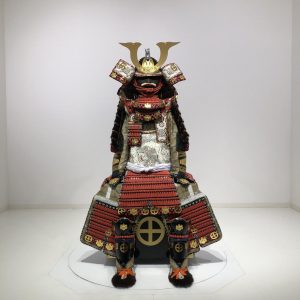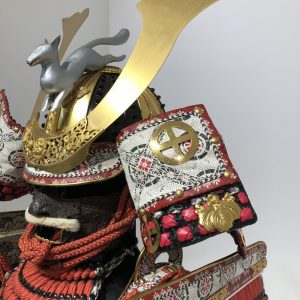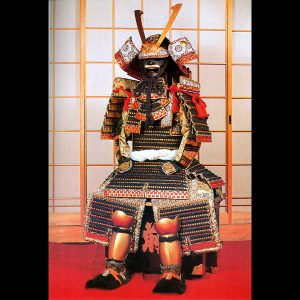Antique Edo Period Gomai Do Samurai Armor with Tokubetsu Kicho Shiryo Certificate (A-51)
Period: Mid Edo Period (1688-1800)
appraised by The Association for the Research and Preservation of Japanese Helmets and Armor on September 14th 2025. We are expecting to receive its certificate in 2-3 months.
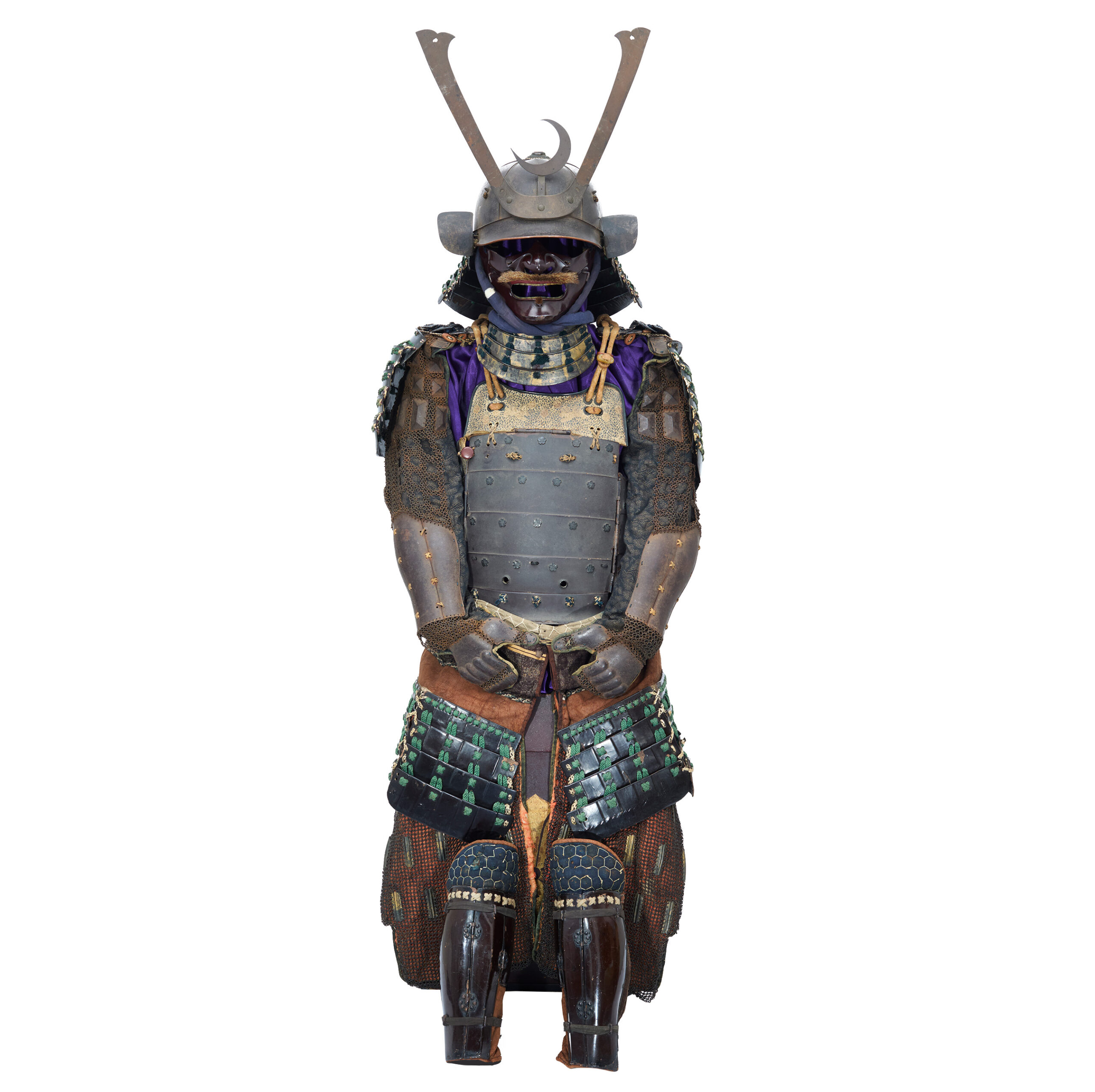
Kabuto (helmet)
■Helmet bowl: Suji Kabuto
Suji Kabuto consists of many small riveted iron plates to form its shape. This helmet has five iron plates. Suji means a stripe in Japanese, and you can see 5 stripes in this helmet. A high-class Samurai might have owned this helmet.
The Kabuto (兜, helmet) is a protector for the head. When people started using the Kabuto, it was initially designed for practical use. However, the principal purpose of its design has changed with time; Samurais tried to express their dignity, personality, or religion by wearing the characteristic design Kabutos. According to a theory, these unique designed Kabutos were made from the late Muromachi period to the Edo period. This type of Kabuto is categorized as the Kawari Kabuto (変わり兜), and a variety of materials were used to create them. For example, animal fur, seashells, plants, and papers were used as materials for decoration.
Before the Kawari Kabuto’s production, the Suji Kabuto (筋兜) has appeared during the Nanbokuchou (南北朝, 1337-1392) period. At that time, the tactic was gradually changed from the piggyback fight style to battle with the Tachi (太刀) sword and the Naginata (薙刀, Japanese halberd) on the ground. Therefore, there was a rise in demand for the weight saving of the Kabuto. Also, in order to turn the attack by swords, a new type of structure was invented; it is the Suji Kabuto (筋兜). Its form slides swords’ attacks when weapons hit the Kabuto. It is said that the production of the Suji Kabuto prospered in the Muromachi (室町, 1336-1573) period. The Suji Kabuto production continued in the Edo period also; however, iron plates that Kabuto makers used at that time were thicker than the Muromachi period’s Suji Kabuto. Therefore, it was heavier, and we understand that then people cherished the Suji Kabuto to enjoy the old-style Kabuto, not to wear it on the battlefields.
This particular helmet features a Tetsusabi-iro Urushi-nuri (鉄錆色漆塗) finish, which means “iron-rust-colored lacquer coating.” Rather than exposing the raw iron or using a brightly colored lacquer, this finish mimics the subdued, aged tone of oxidized iron. It provides both protection and aesthetic value, blending durability with a refined, understated appearance that reflects the samurai ideal of quiet strength and elegance.
Inside the helmet, there is inscription, saying that Myochin Sosen Eiji Nenkan Mune 〇 (明珍祖先永治年間宗〇). Myochin is the name of a famous armor-making school that has been continuing for generations since the Heian period. Mochin school originally was founded in Kyoto area. And, members of this school moved to other parts of Japan, including Jyoshu (Gunma), Soshu (Kanagawa), Echizen (Fukui), Kaga (Ishikawa). Sosen means ancestor in Japnaese. Eiji Nenkan is 1141-1142. While letter Mune (宗) is legible the other letter is not. That is why we put 〇 to signify there is a letter there while it is not fathomable. This inscription means that Mune〇 is the maker whose ancestor was Moychin from 1141-1142 (Heian period).
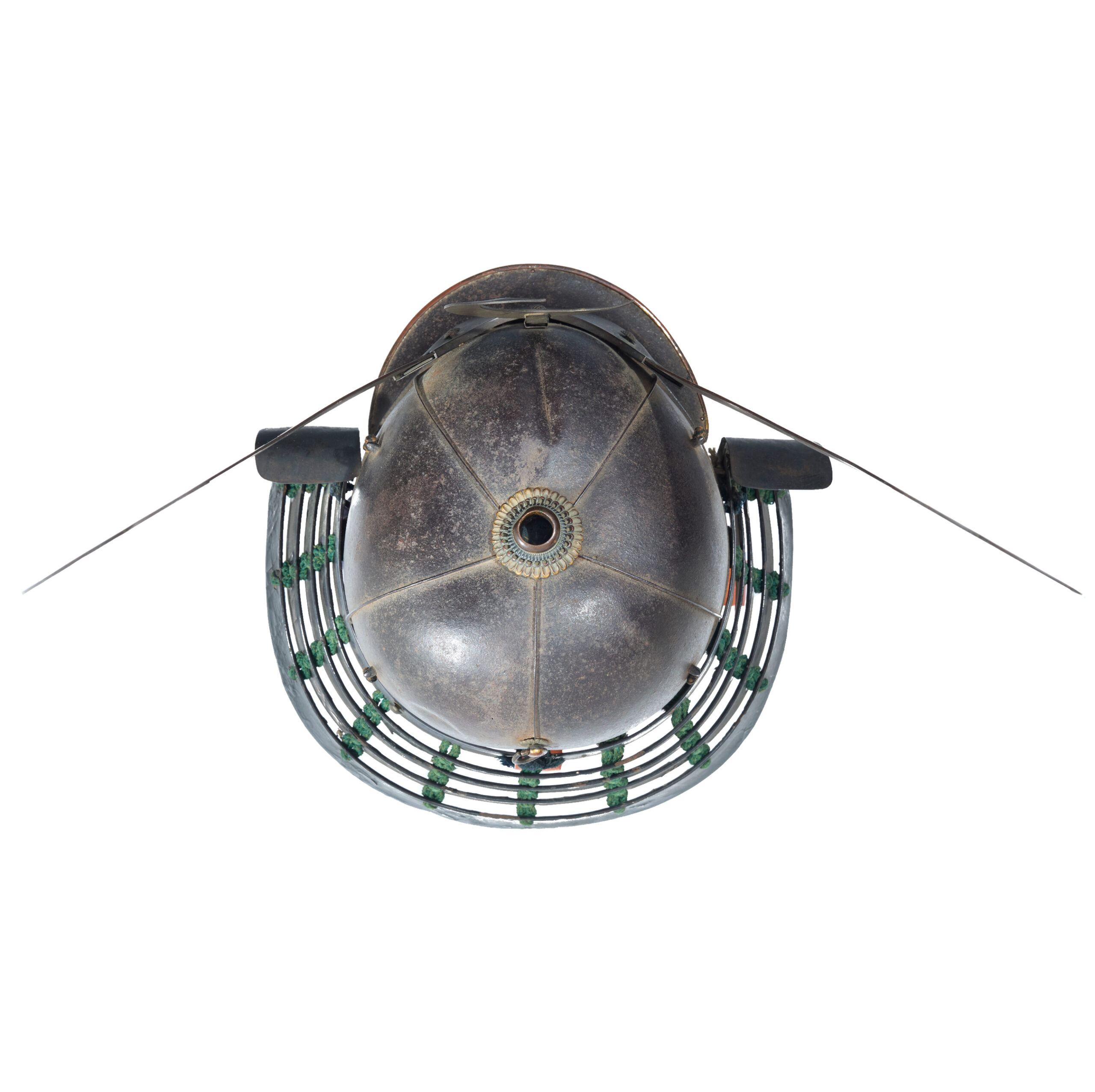
■Shikoro (side neck guard):
Black lacquered plates laced with light green threads.
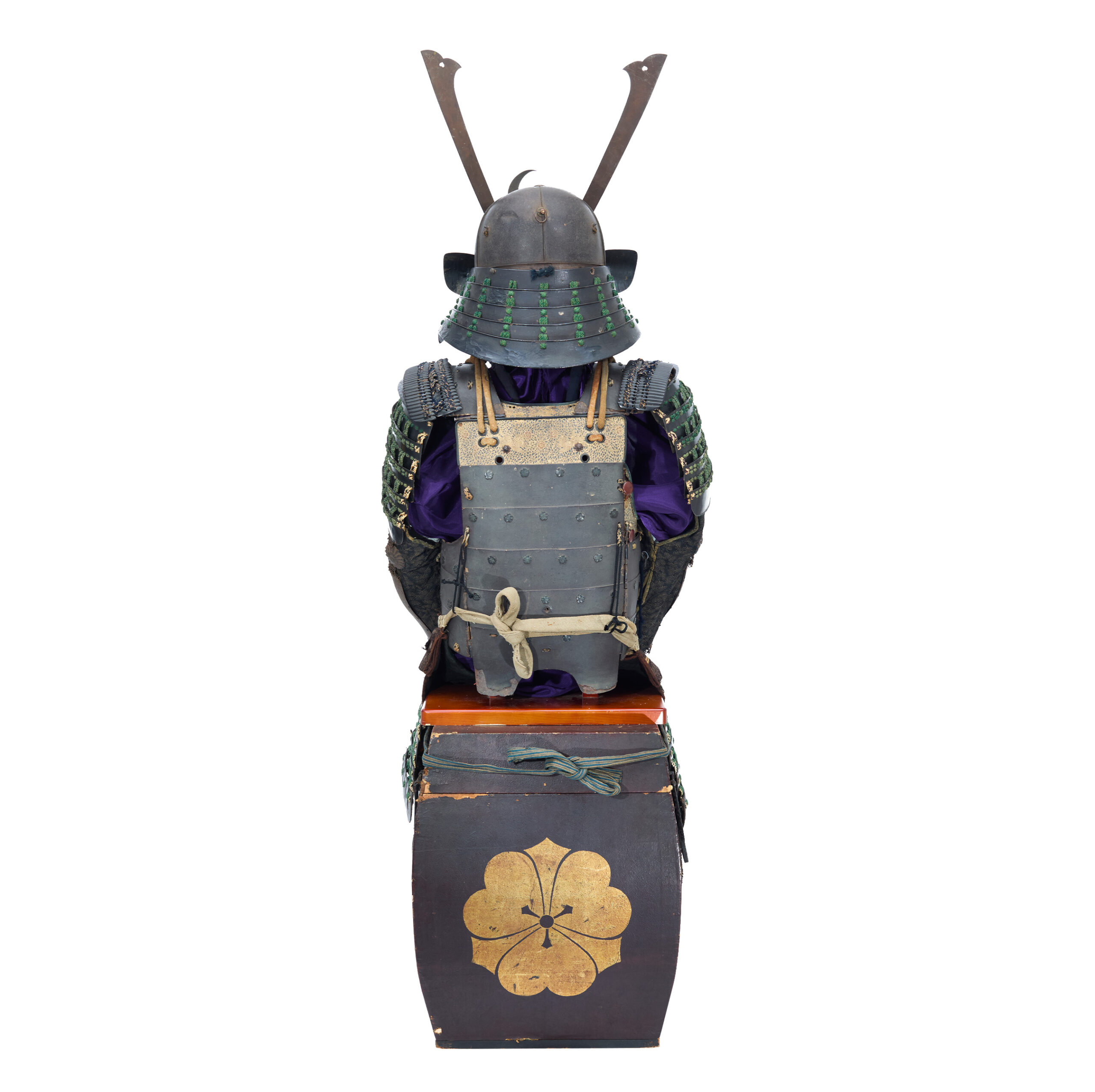
■Fukikaeshi (side neck guard)
The fukikaeshi are the side flaps attached to both ends of a samurai helmet (kabuto). They served a defensive function by protecting the face from sword strikes, while also providing space for decorative designs that indicated the warrior’s status or affiliation. In this example, the fukikaeshi are finished in the same tetsusabi-iro urushi-nuri (iron-rust-colored lacquer coating) as the helmet bowl. Unlike many helmets that feature family crests or ornate embellishments, these are left plain, giving them a rugged and austere appearance. This simplicity emphasizes a sense of strength and conveys the impression of practical, battlefield-oriented armor.
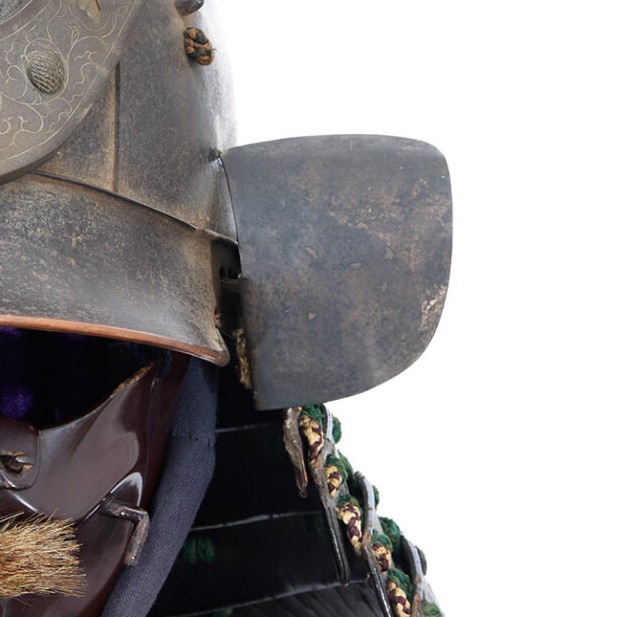
■Menpo (face guard): Ressēmen (烈勢面)
This type of menpō (face guard) is called a ressēmen (烈勢面). The name literally means “fierce expression mask.” As the term suggests, it was crafted to give the wearer a fearsome look on the battlefield. Such masks not only provided protection for the face but also served a psychological purpose—intimidating opponents and expressing the warrior’s spirit.
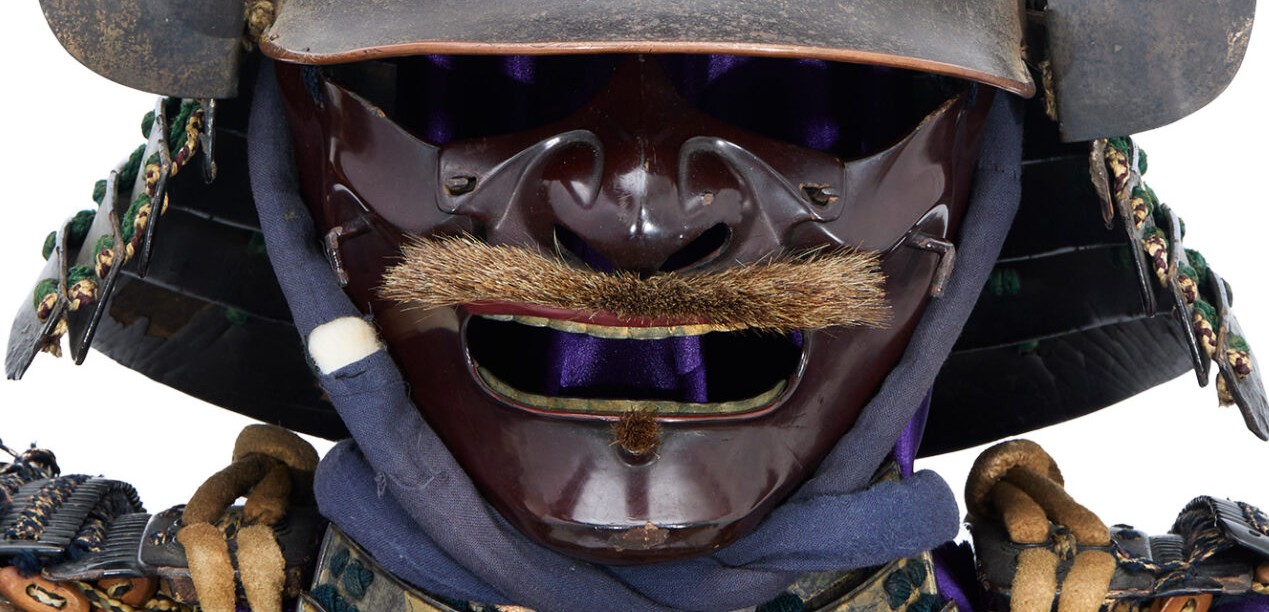
■ Kuwagata (Front decoration): Mikazuki (三日月, crescent moon)
The kuwagata is attached to this kabuto as a type of maedatemono (前立物, front decoration) to dignify and enhance its appearance. The shape of this kuwagata features bifurcated tips, crafted from a single metal plate, giving it a simple yet commanding presence. Although there are minor scratches and small damages, they remain as traces of its long history and can be appreciated as part of its antique texture.
At the tips of each end, the inome (猪の目, boar’s eye) pattern is engraved. This design, resembling a heart shape, has been used since ancient times as a charm believed to ward off evil spirits and fire, while also inviting good fortune.
The maedatemono is attached to this kabuto. The motif of this maetate is a crescent moon (三日月, mikazuki). In Japanese culture, the crescent moon has long symbolized elegance, renewal, and the passage of time, while on the battlefield it conveyed quiet strength and unwavering determination. The most famous example of such a design is the crescent moon crest helmet worn by the warlord Date Masamune (1567–1636), which became his enduring symbol.
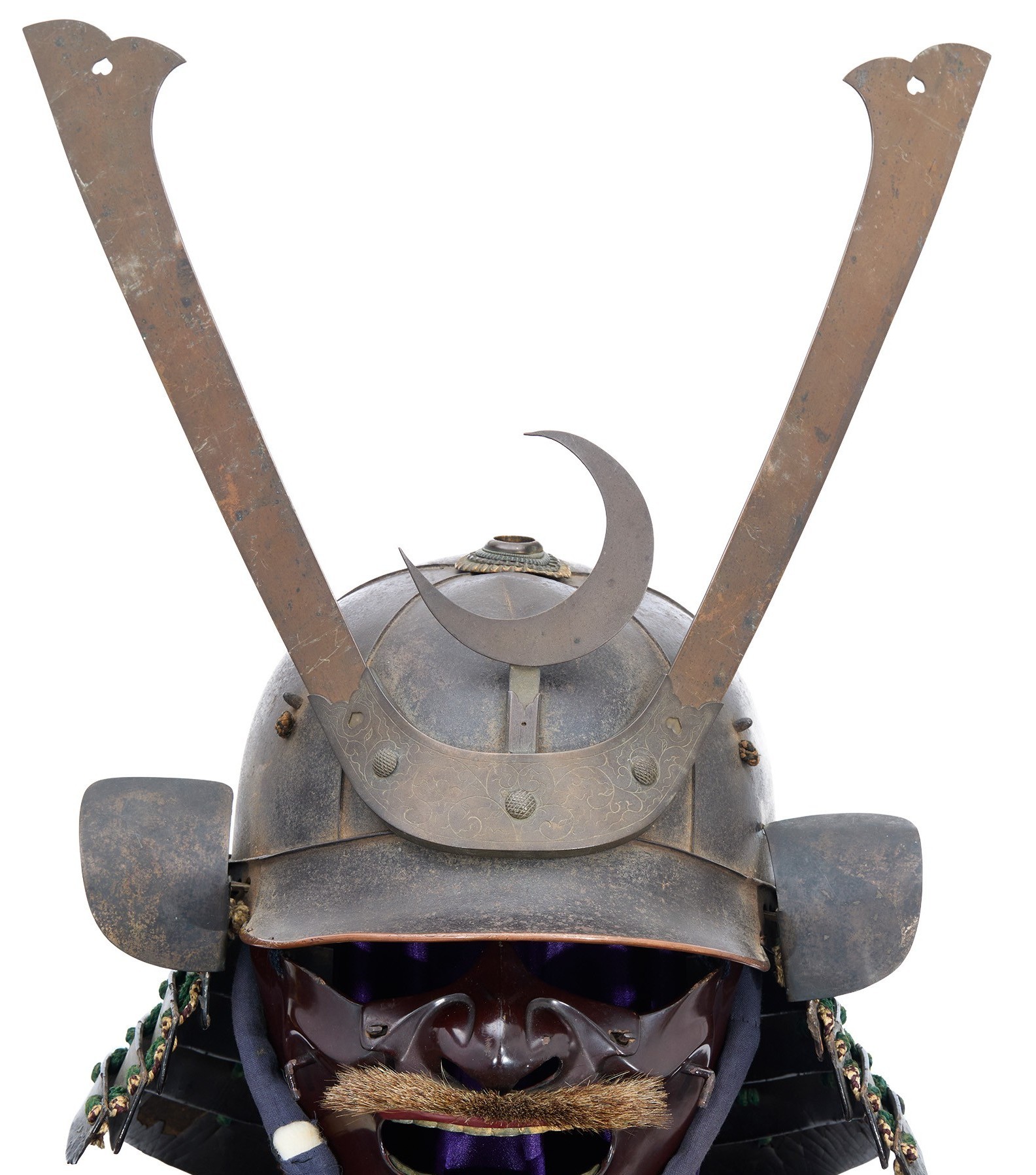
Armor
■ Dō (cuirass): Gomai Dō (五枚胴)
The Go Dō (五枚胴) is a type of cuirass used in Tōsei Gusoku (当世具足, “modern armor” developed during the Sengoku period). The term Gomai (五枚) means “five plates,” while Dō (胴) refers to the torso; hence, this cuirass is named for its five-piece construction. Unlike earlier armors made primarily from numerous small lamellar plates (kozane, 小札), this style uses larger iron plates to provide stronger and more practical protection.
The floral design on the torso of this armor is based on the motif of cherry blossoms (桜, sakura). For centuries, cherry blossoms have been cherished in Japan as symbols of fleeting beauty as well as renewal and the cycle of life. In addition, around the knot above the cuirass, there appears to be a design depicting lions (獅子, shishi). In Japanese culture, lions symbolize courage and protection, believed to ward off evil and grant strength to warriors.
*Please keep in mind that there is no Kosazuri for this armor. The front part of the armor is covered with Kusazuri-like Haidate and the back of the torso looks different from the regular armor with Kusazuri.
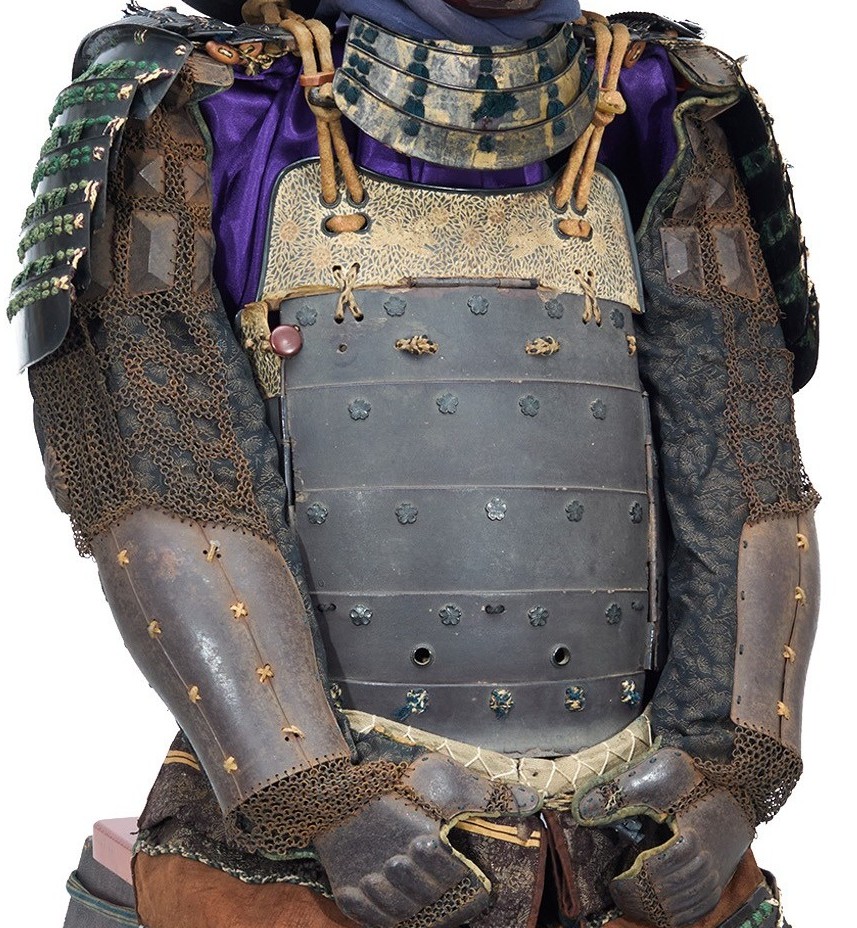
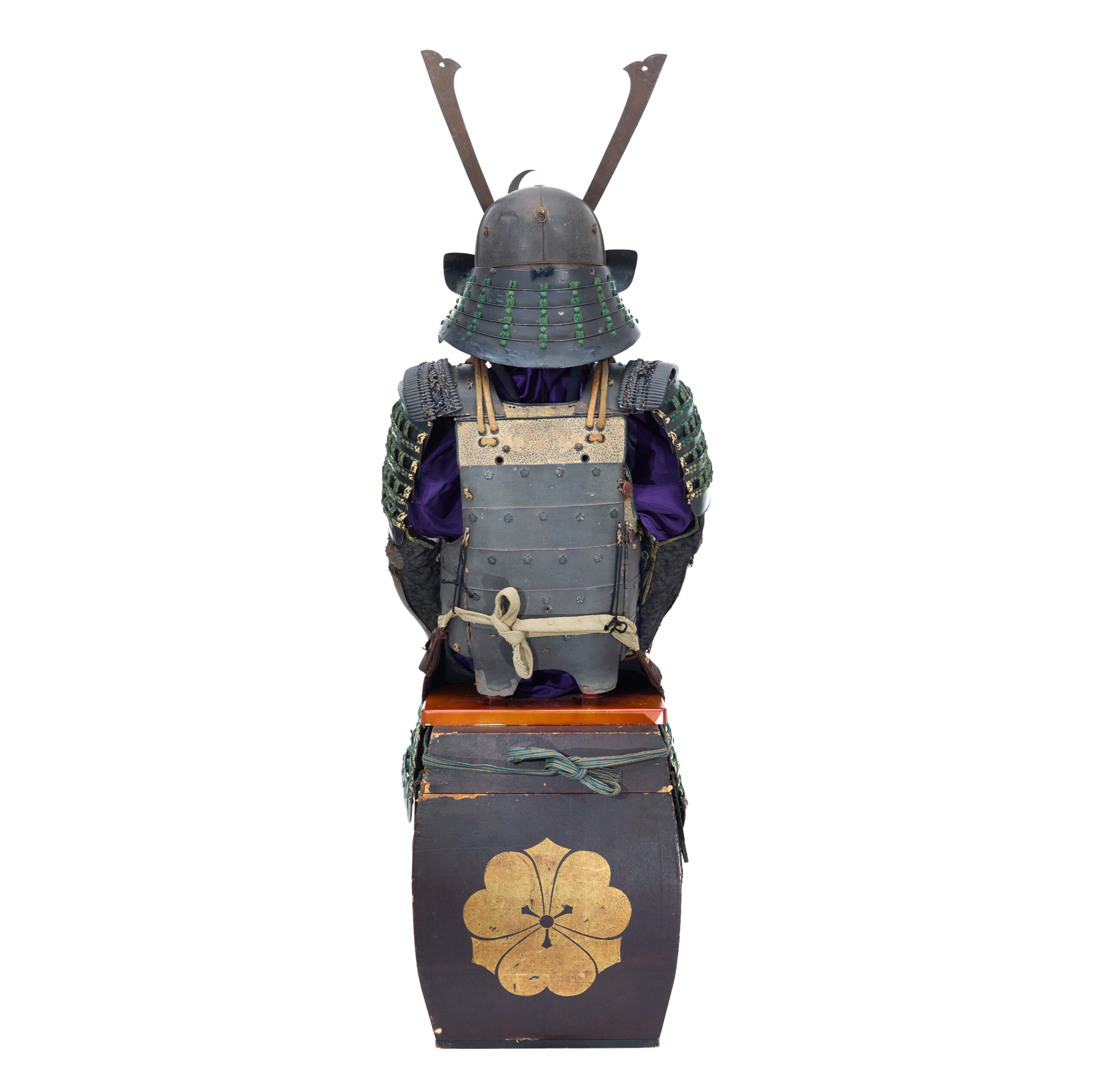
Small parts
■Kote (armored sleeves):
Intricately crafted with iron chain mail interwoven with silk. On the middle section of the back of the hand, a cherry blossom crest (sakura mon) is prominently featured. The finger-covering plates bear diamond-shaped (hishi) patterns, along with what appears to be a design associated with the Takeda family crest (武田菱, Takeda-bishi), a motif strongly connected to the famous Takeda clan of the Sengoku period.
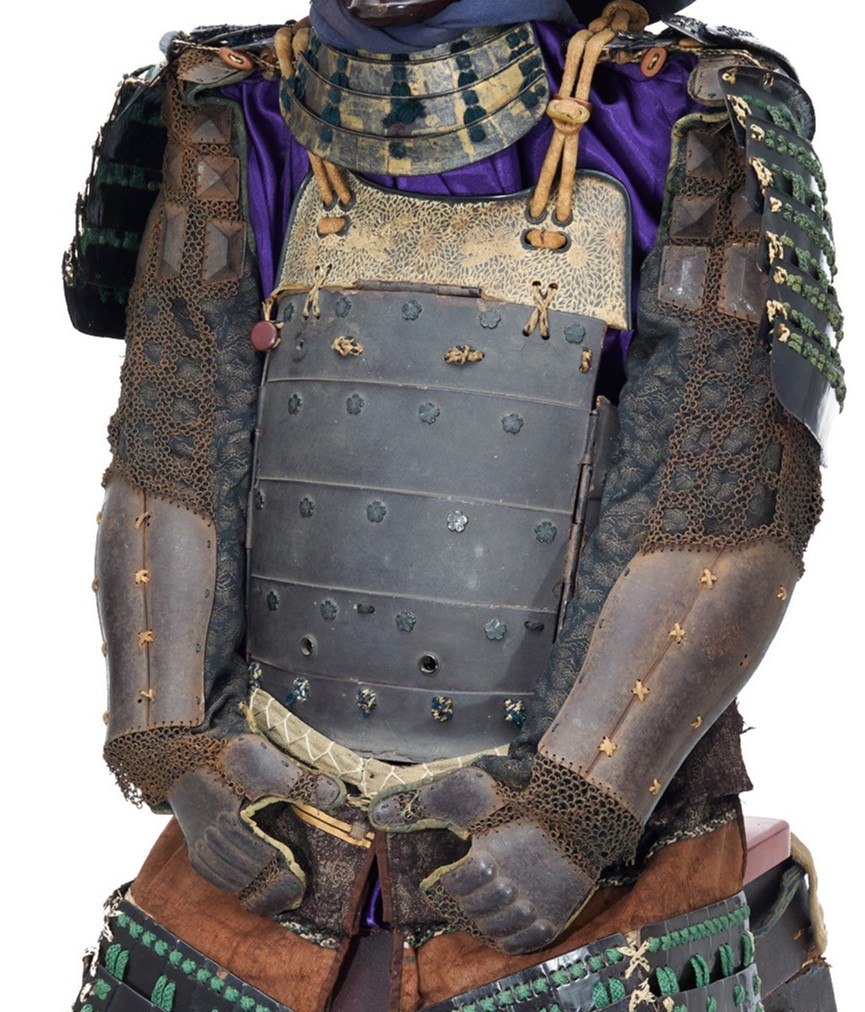
■Haidate (thigh protection):
The haidate is a type of thigh guard, consisting of cloth backing reinforced with chain mail and iron plates.
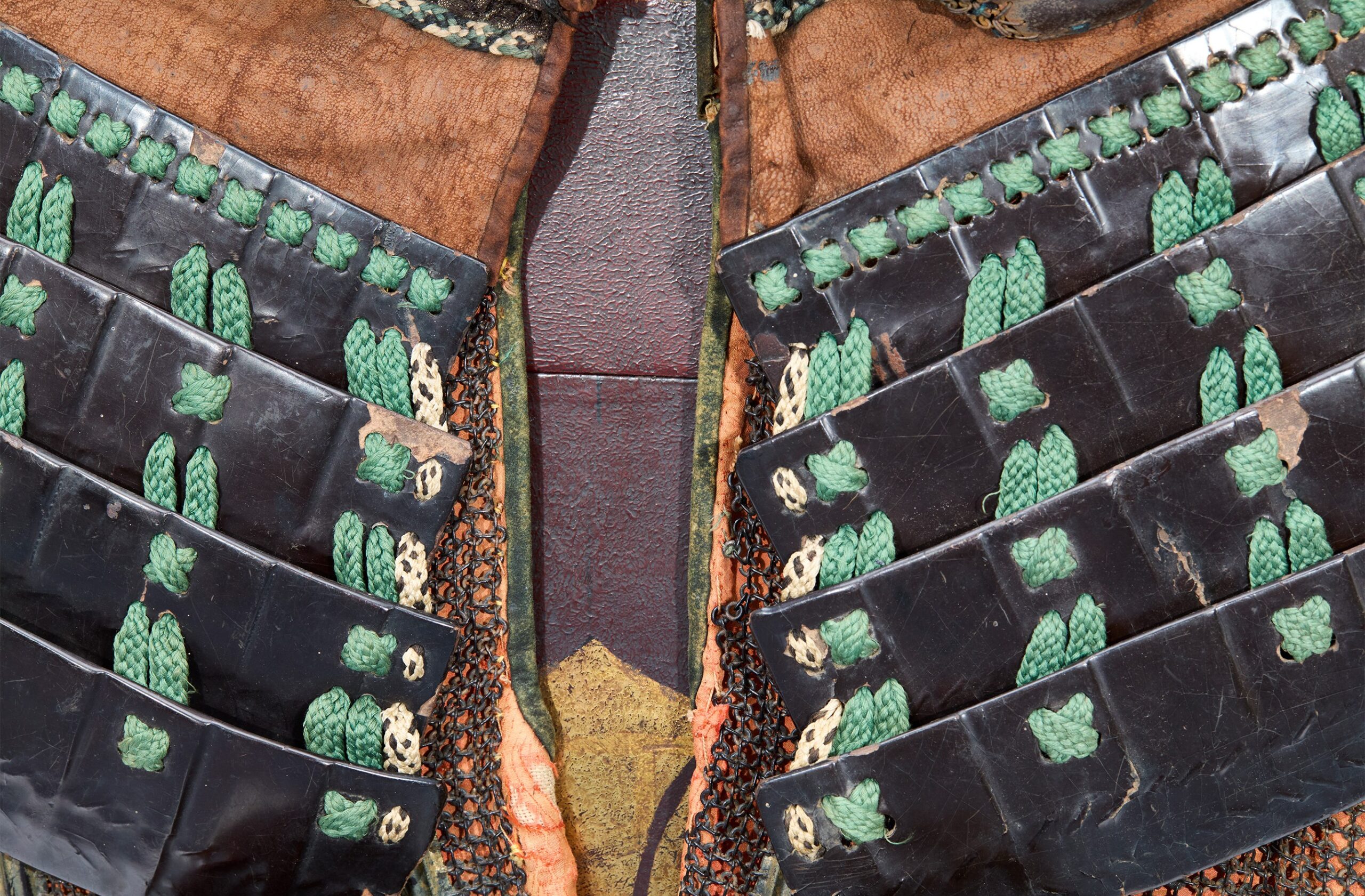
■Suneate (shin guard):
The Kikkou (亀甲, turtle’s shell) pattern is used for the cloth of the Suneate (脛当). It is a continuous geometric pattern connecting regular hexagons up and down. A theory says that this design was brought from China and the Korean Peninsula during the Asuka (飛鳥, 592-710) and Nara (奈良, 710-794) periods. A proverb says turtles live long lives; therefore, turtle and turtle shell patterns represent longevity. In addition, as this continuous hexagonal pattern does not get out of its shape, it is said people wished for eternal prosperity by using this design. This Suneate is a type called Kusari sunete (chain armor shin guard). It features chains attached to fabric, with minimal gaps between the metal links.
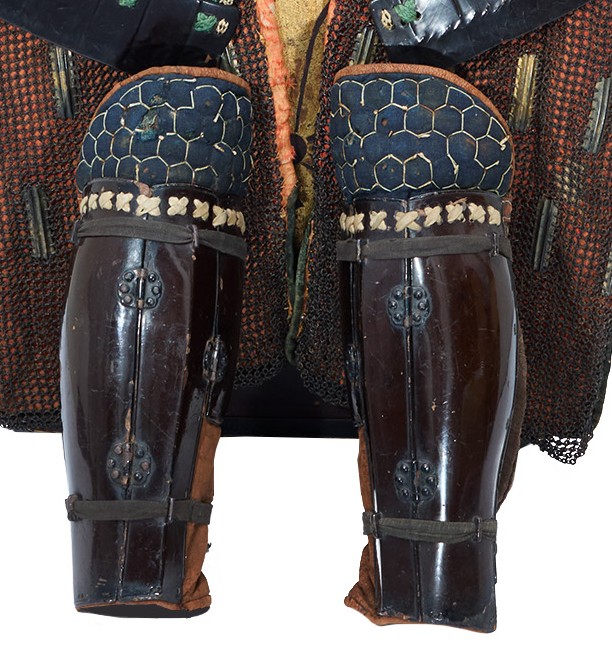
■Kacchu Hitsu (armor box)
This armor box is decorated with a family crest (家紋, kamon) known as Ken Katabami (剣片喰). The crest features the katabami (wood sorrel) motif combined with sword shapes, symbolizing both resilience and martial strength. Such crests were often used by samurai families to represent their identity and values.
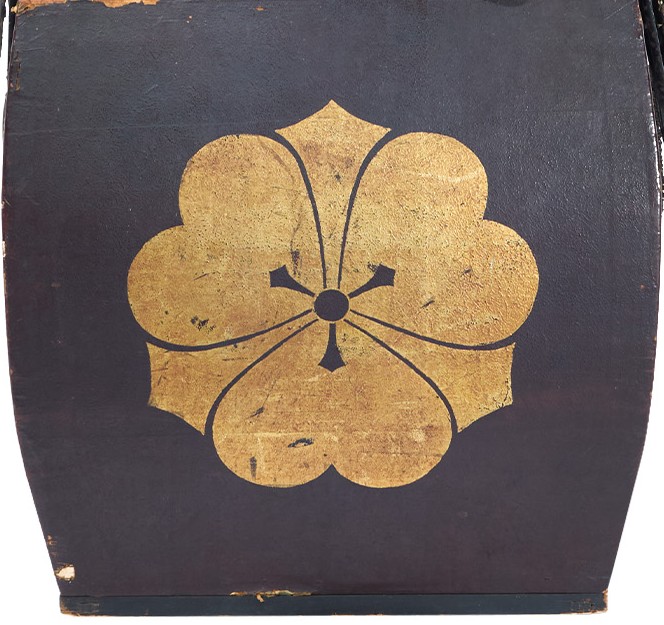
Certification: Tokubetsu Kicho Shiryo Certificate
On September 14th 2025, this armor was appraised as a Tokubetsu Kicho Shiryo by The Association for the Research and Preservation of Japanese Helmets and Armor, which is the most trusted Japanese armor appraiser in Japan. This association is also known as Nihon Katchu Bugu Kenkyu Hozonkai (日本甲冑武具研究保存会). Tokubestu Kicho Shiryo (特別貴重資料) means special rare article. It is ranked as the third highest of five rankings. We can ship this armor first and send the certificate later.
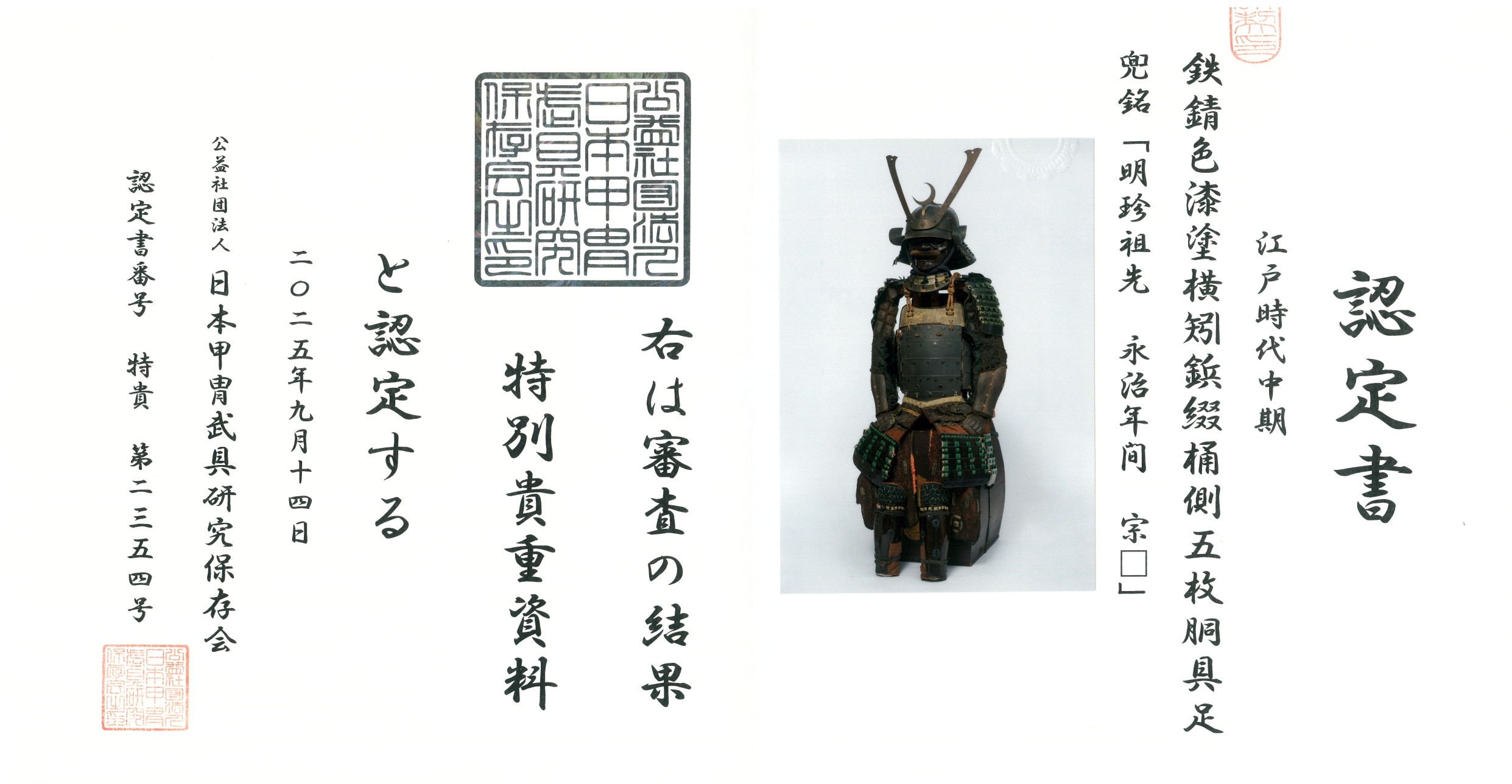
【About us】
Samurai Museum is located in Tokyo, Japan, exhibiting antique artifacts related to the Samurai history. Samurai Museum Shop is the place for those who are interested in Japanese culture and craftsmanship. We deal with antique Samurai swords/armor, traditional crafts made in Japan and so on.
【Antique Japanese Armor and Export process】
After receiving the full payment from you, we will apply for its export permit from the agency for Cultural Affairs to legally export the antique Samurai armor to other countries. It normally takes around 2-4 weeks to receive this permit. And we would like you to expect at least 1-1.5 months for your order to arrive at your given address after you ordered.
【Payment method】
We accept payment through Stripe (Credit card), PayPal, Apple Pay or ChromePay, all of which are secure payment methods. Also, you don’t need to make an account on Stripe for the checkout. If you prefer other payment method, please contact us. You may either pay in JPY, USD, AUD, CAD, EUR, CHF or GBP. The price is set in Japanese Yen. Prices in other currencies are automatically calculated based on the latest exchange rate.

【Shipping duration】
We normally ship via EMS (Express Mail Service) provided by Japan Post. It usually takes at least 5-14 days to deliver the package after you place an order. We offer Free International Shipping as long as we can ship your order by EMS. If you prefer other shipping carriers, please contact us.
We will inform you of the order’s tracking number via email. Please make sure you fill out your valid email address correctly.

【How to make sure the condition】
Please keep in mind that what you are going to purchase is an antique item. We uploaded high resolution photos for you to check its condition thoroughly. If you like to see more photos with different angles, please feel free to contact us. We will be happy to send them to you so that you can make informed decision. It is essential for us to know that you are happy with your choice of a sword. and we are prepared to use the best of our ability to serve you.
【How To Contact Us】
Please contact us through email, Facebook Messenger or Live Chat if you have any questions. You can find each icon on the right side of the website. Please click one of them to reach us. We will reply to you within 1-2 business days.
【How To Preserve Antique Samurai Armor】
Dryness, humidity, and bad ventilation might deteriorate the condition of antique Samurai armor. The best temperature to preserve Samurai armor is around 20℃ in Celsius, and humidity should be about 60%. Direct sunlight should be avoided. We recommend storing armors in a room with good ventilation. If you like to display them outside the boxes for a prolonged time, we suggest using a glass case in order for dust not to be accumulated easily. In case you don’t use a glass case, please make sure to regularly dust off from the armor by using a soft brush made of delicate cloth or brush for painting.
If you like to know more about the preservation of this armor, please feel free to contact us.
